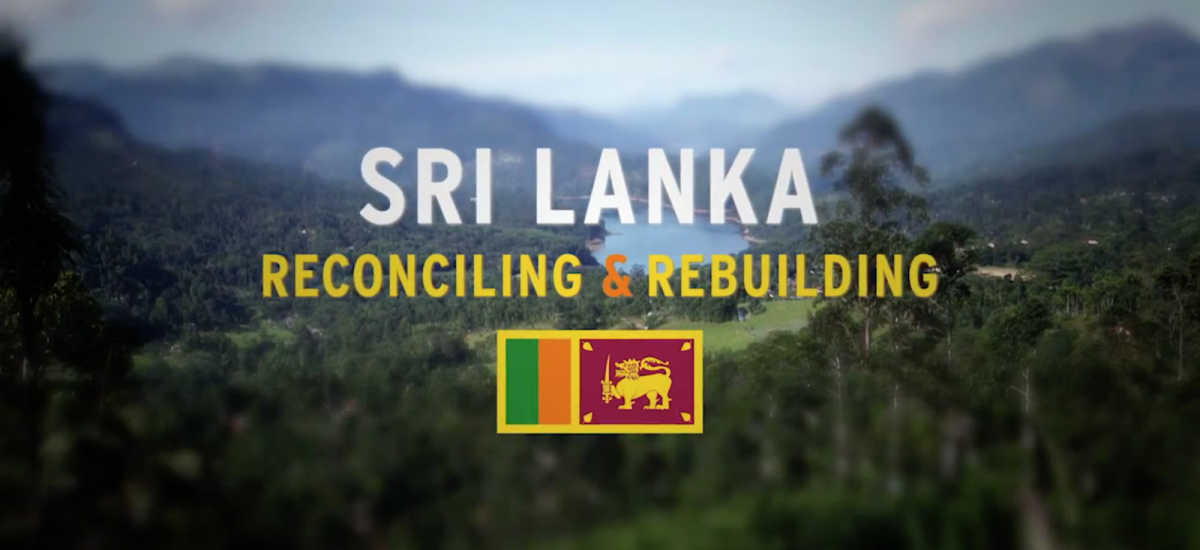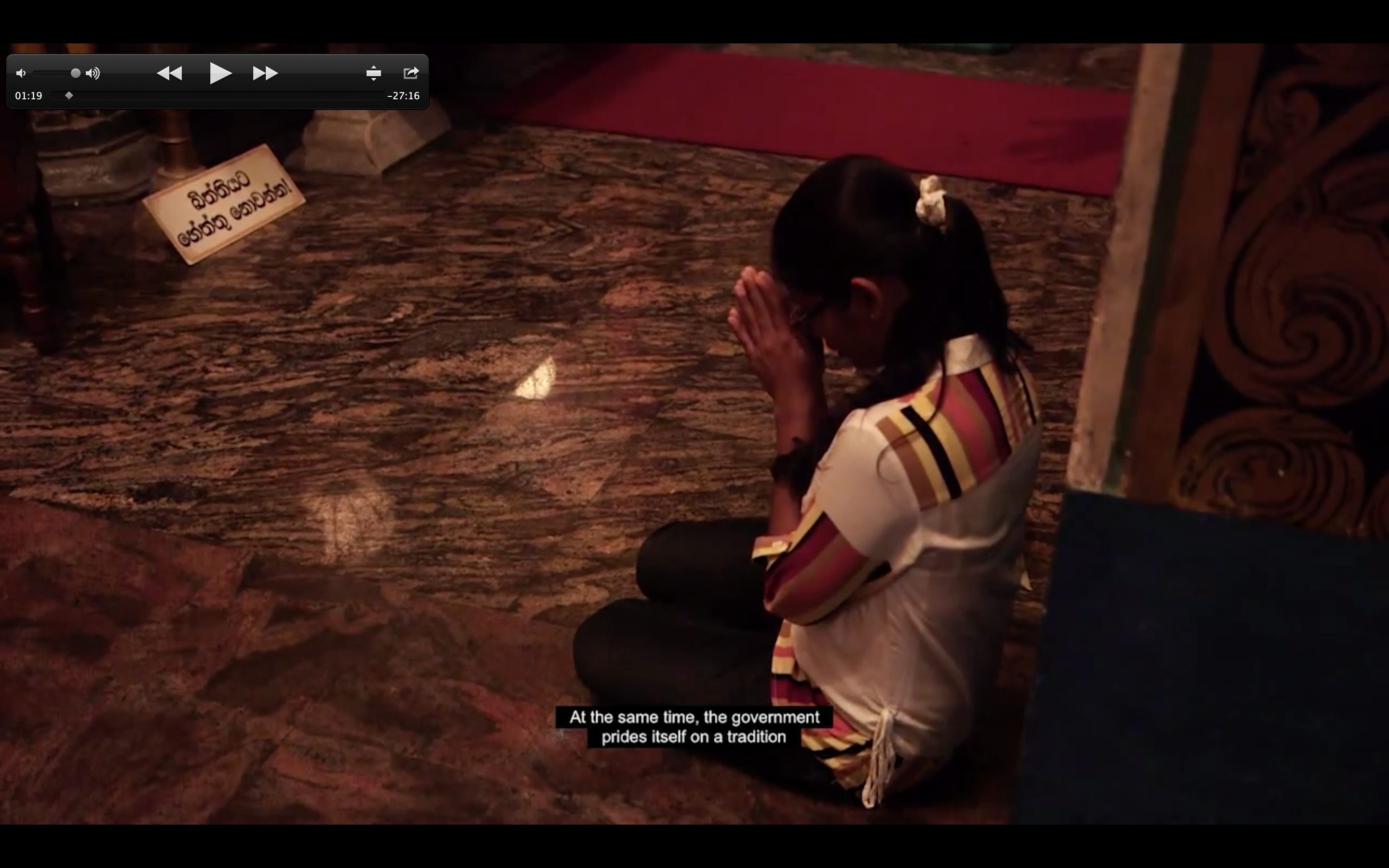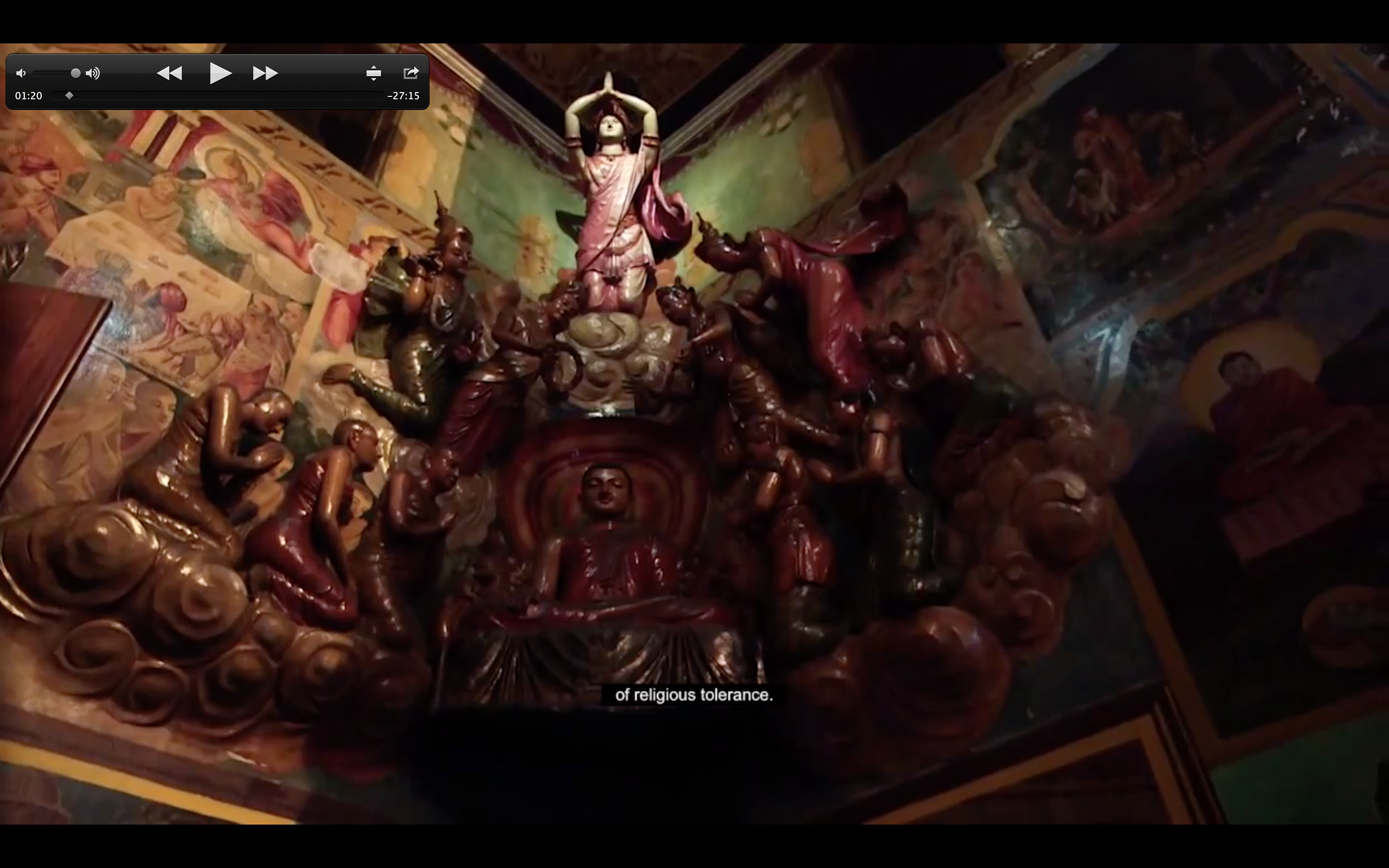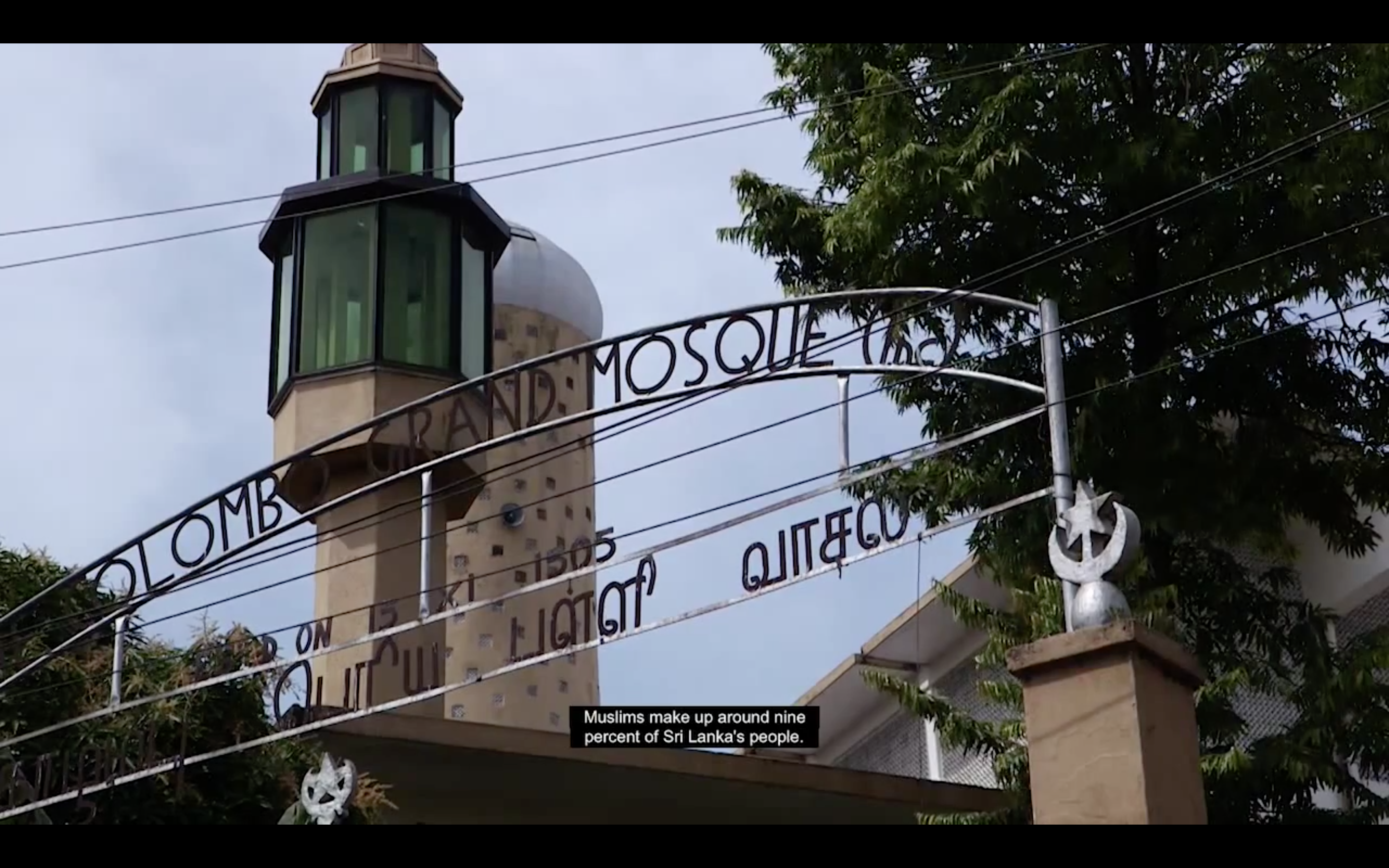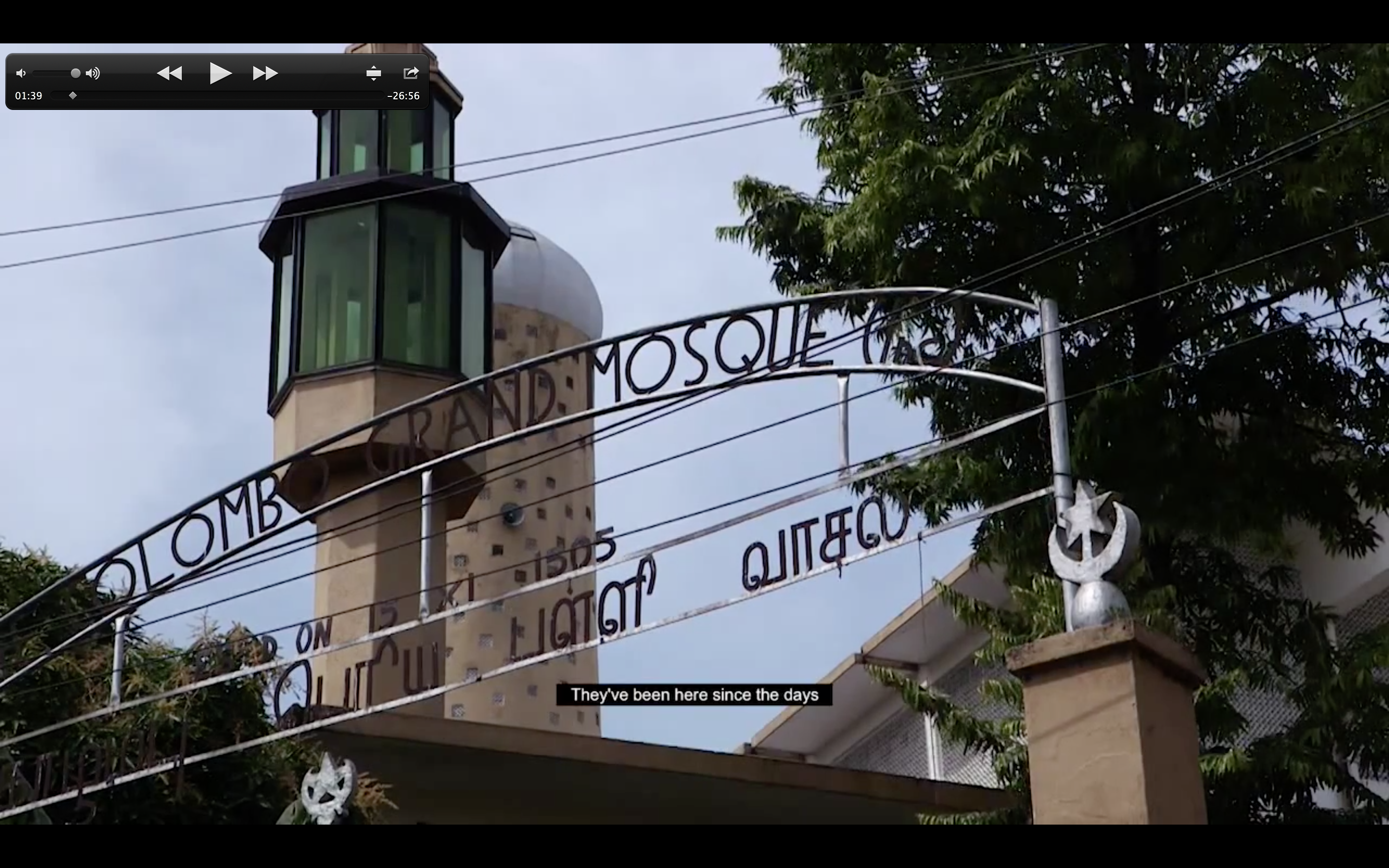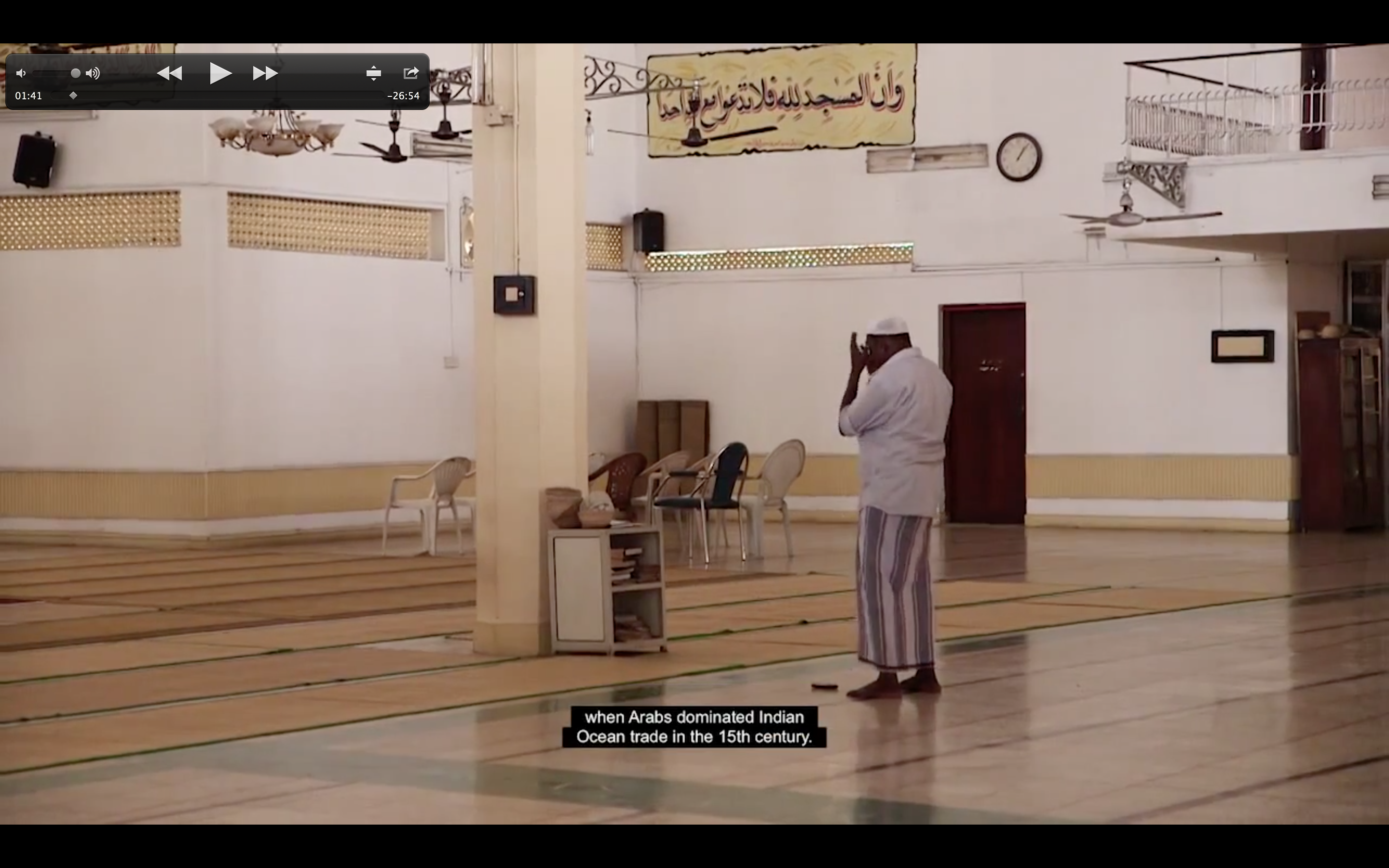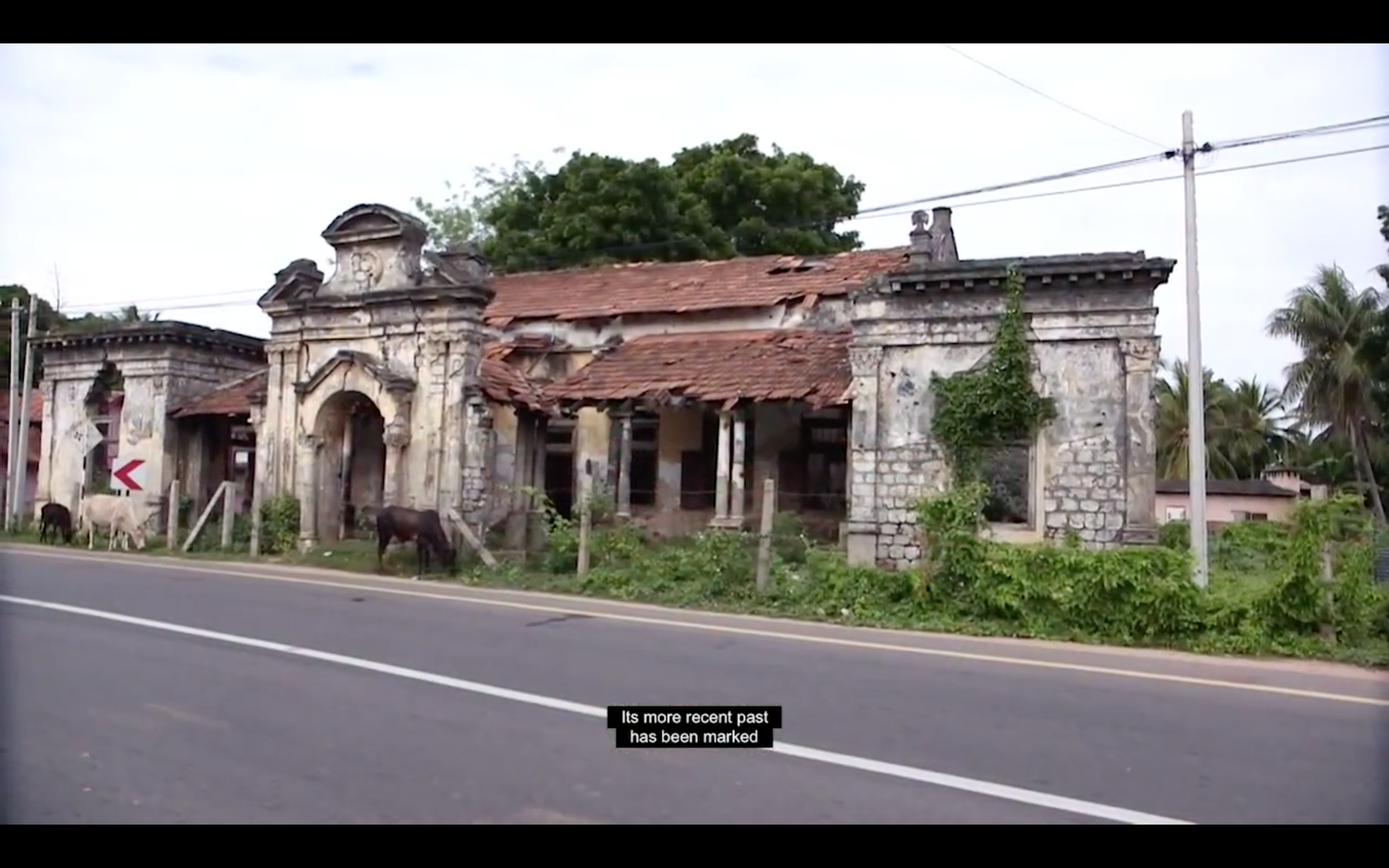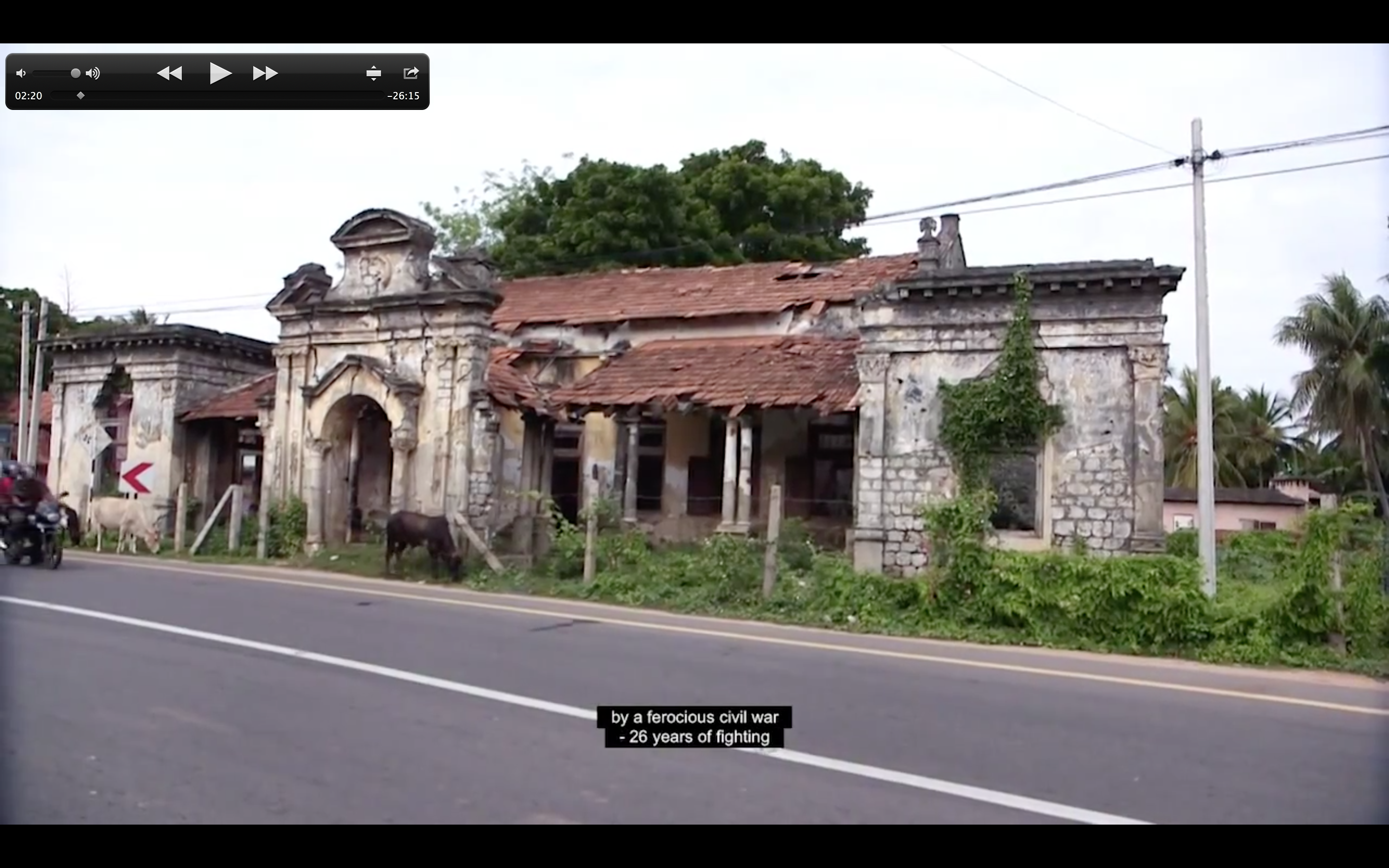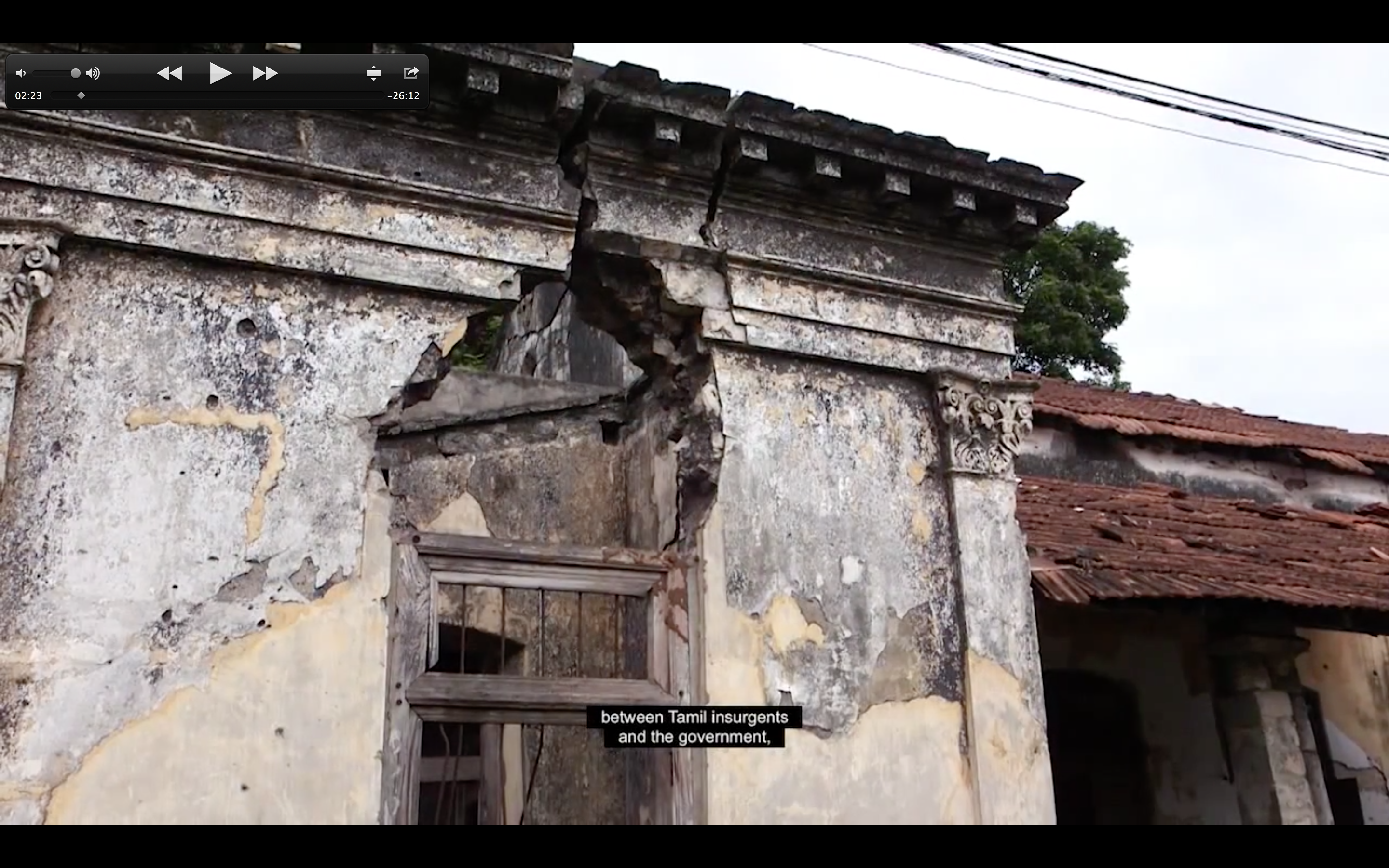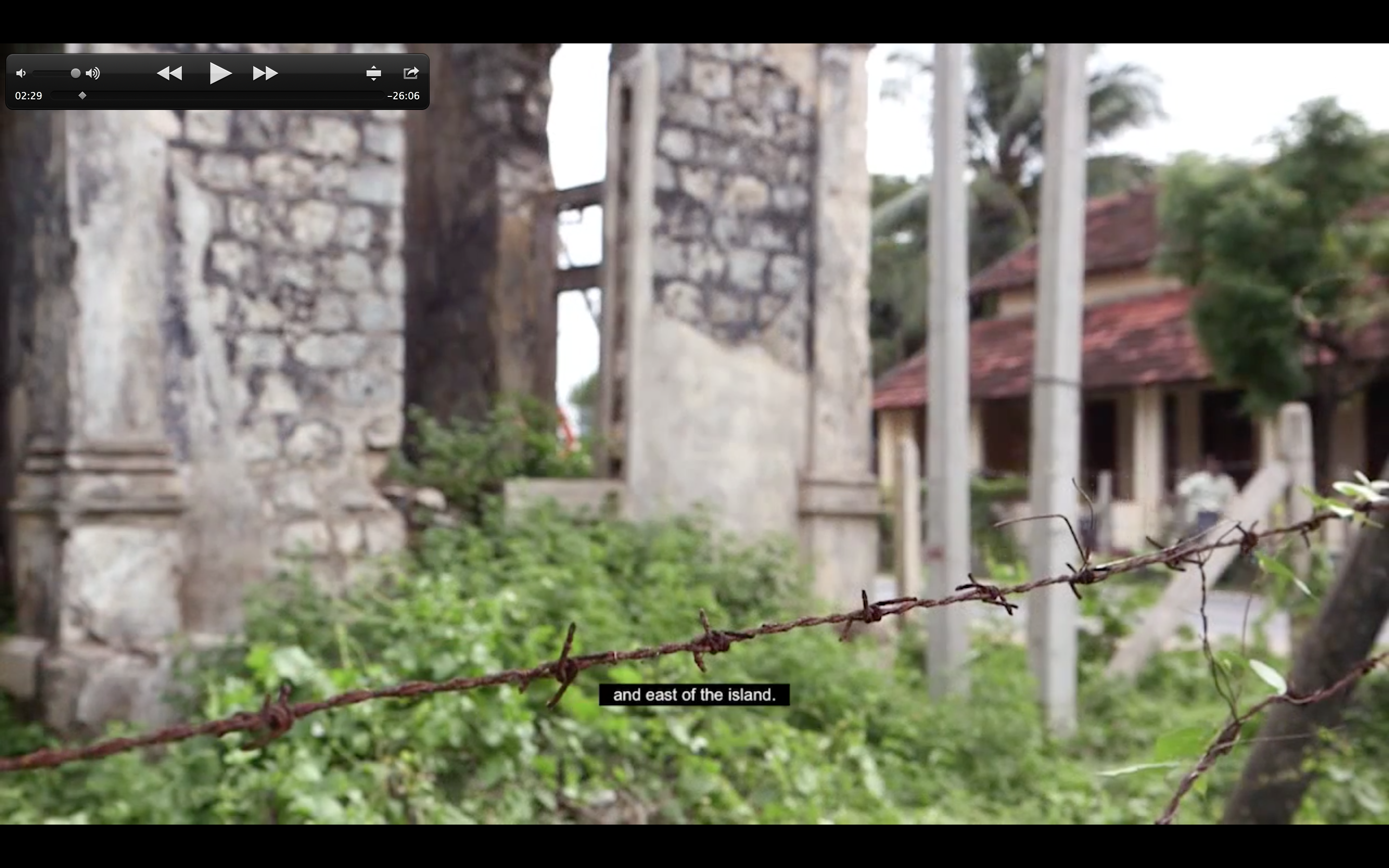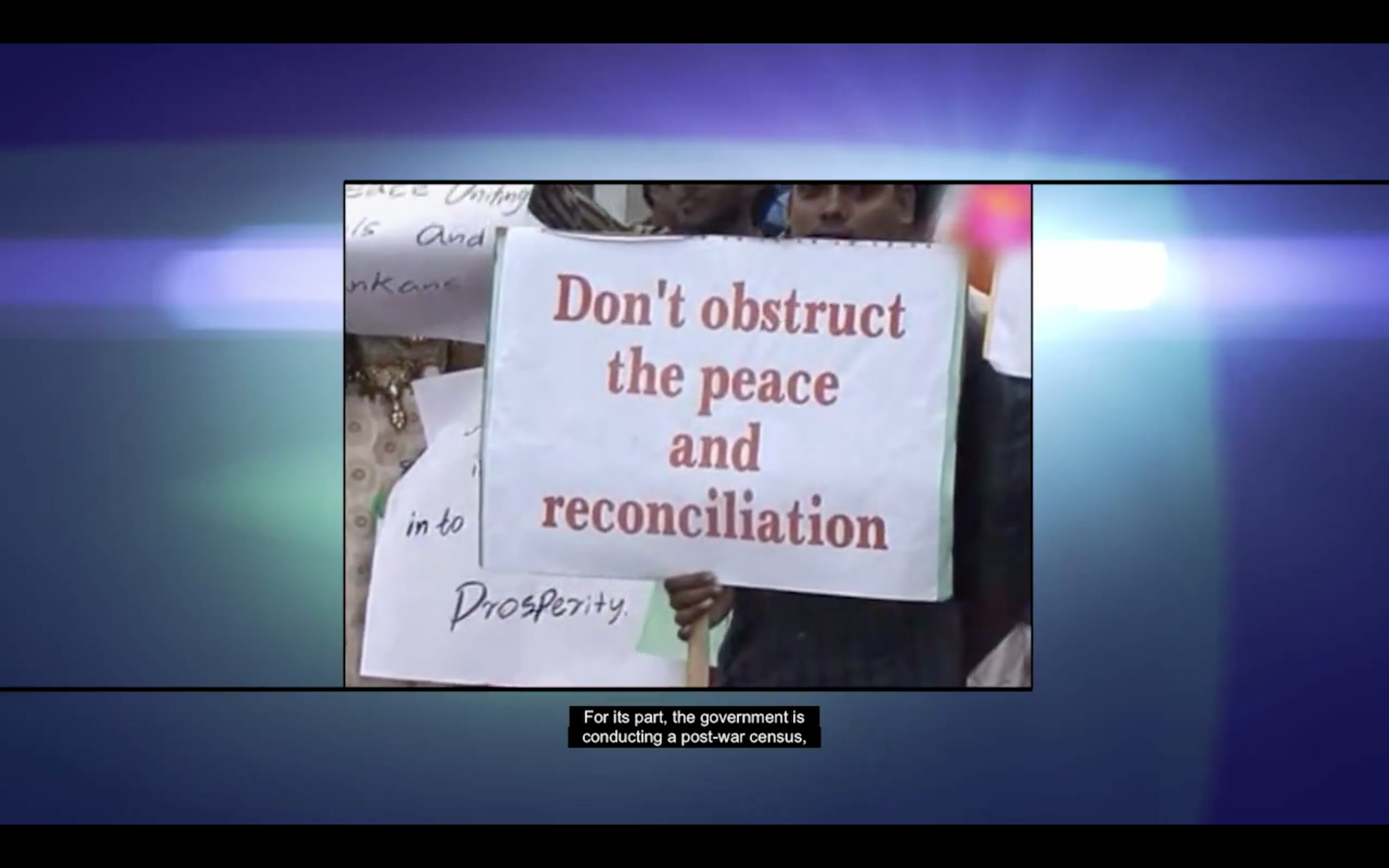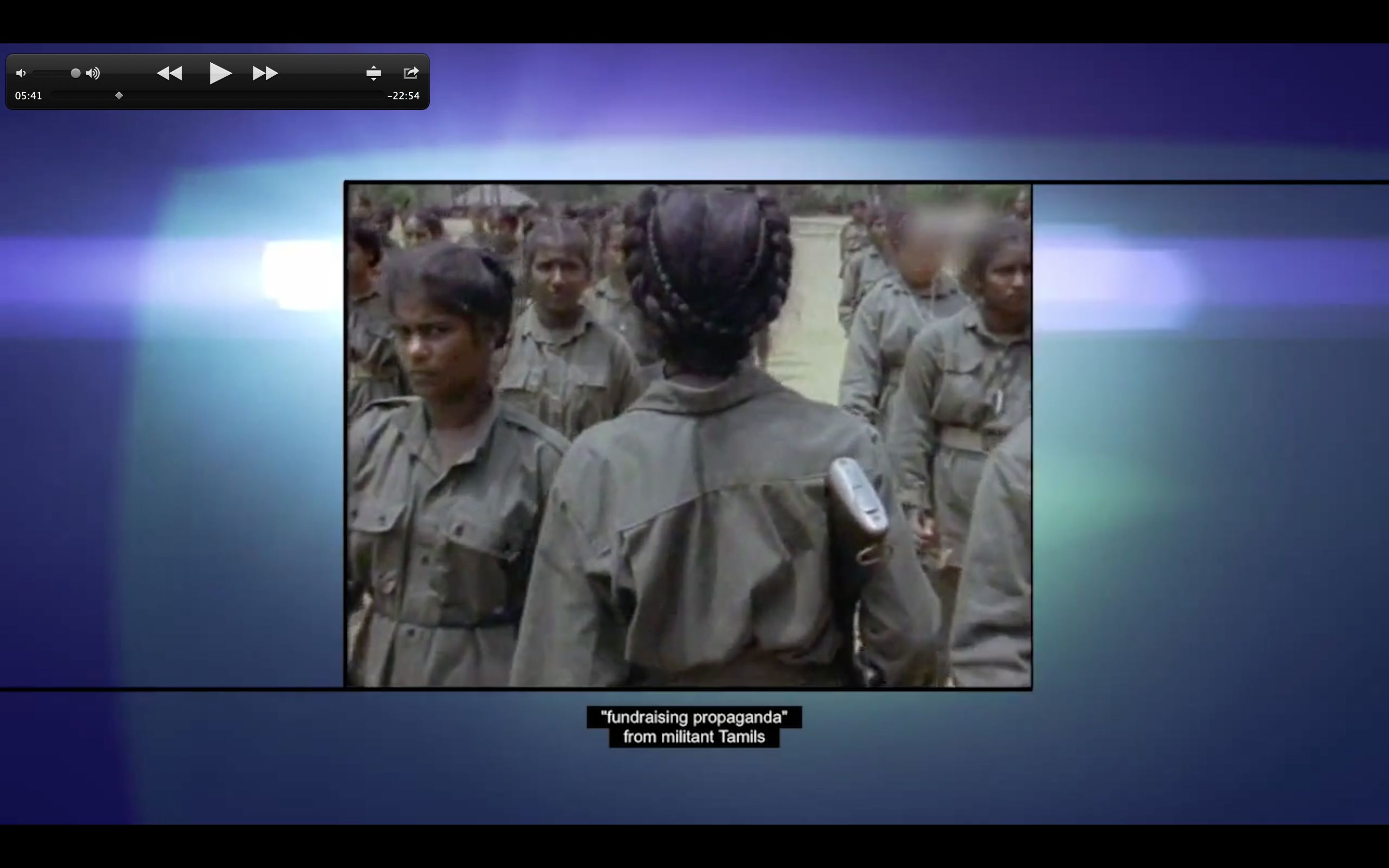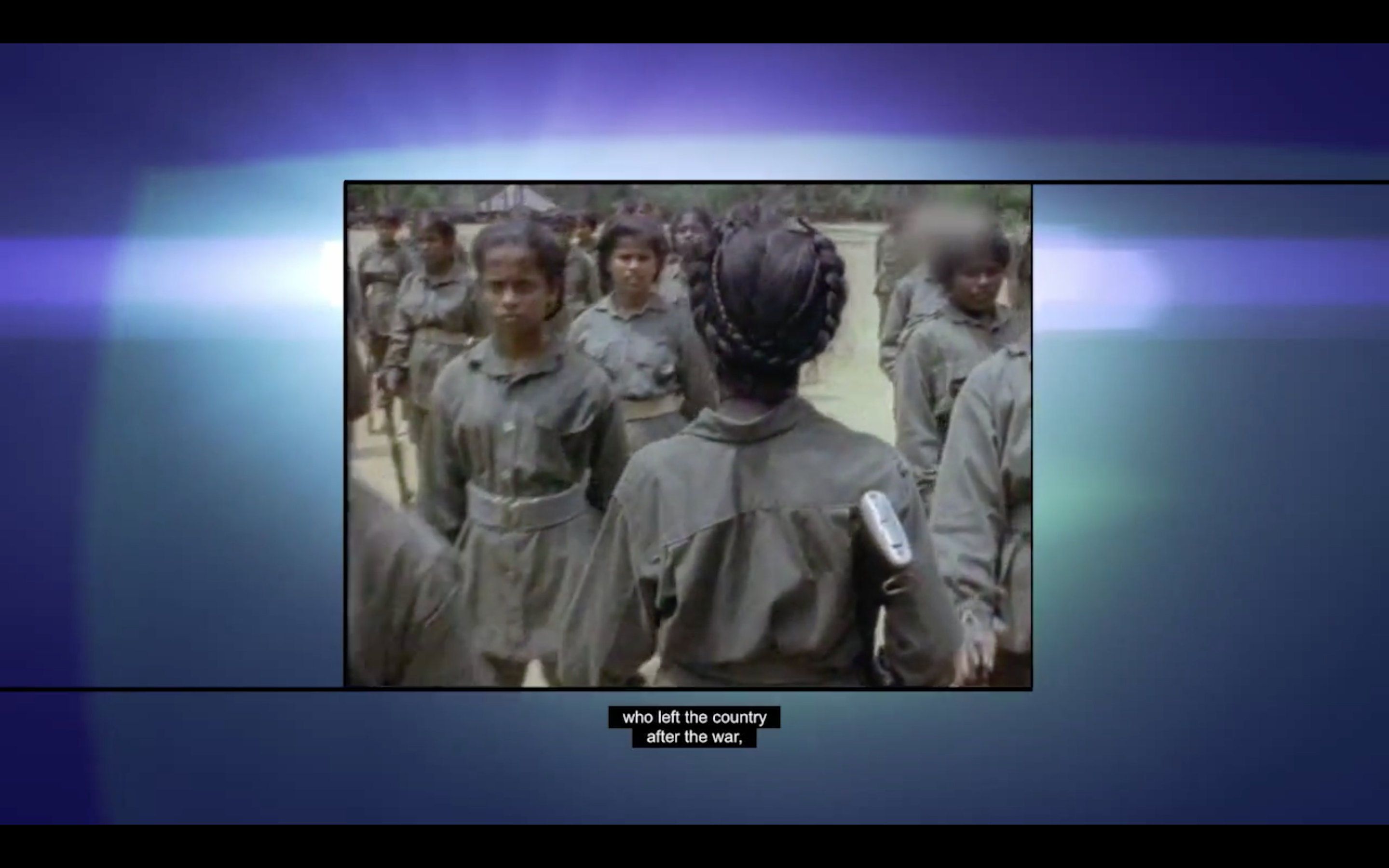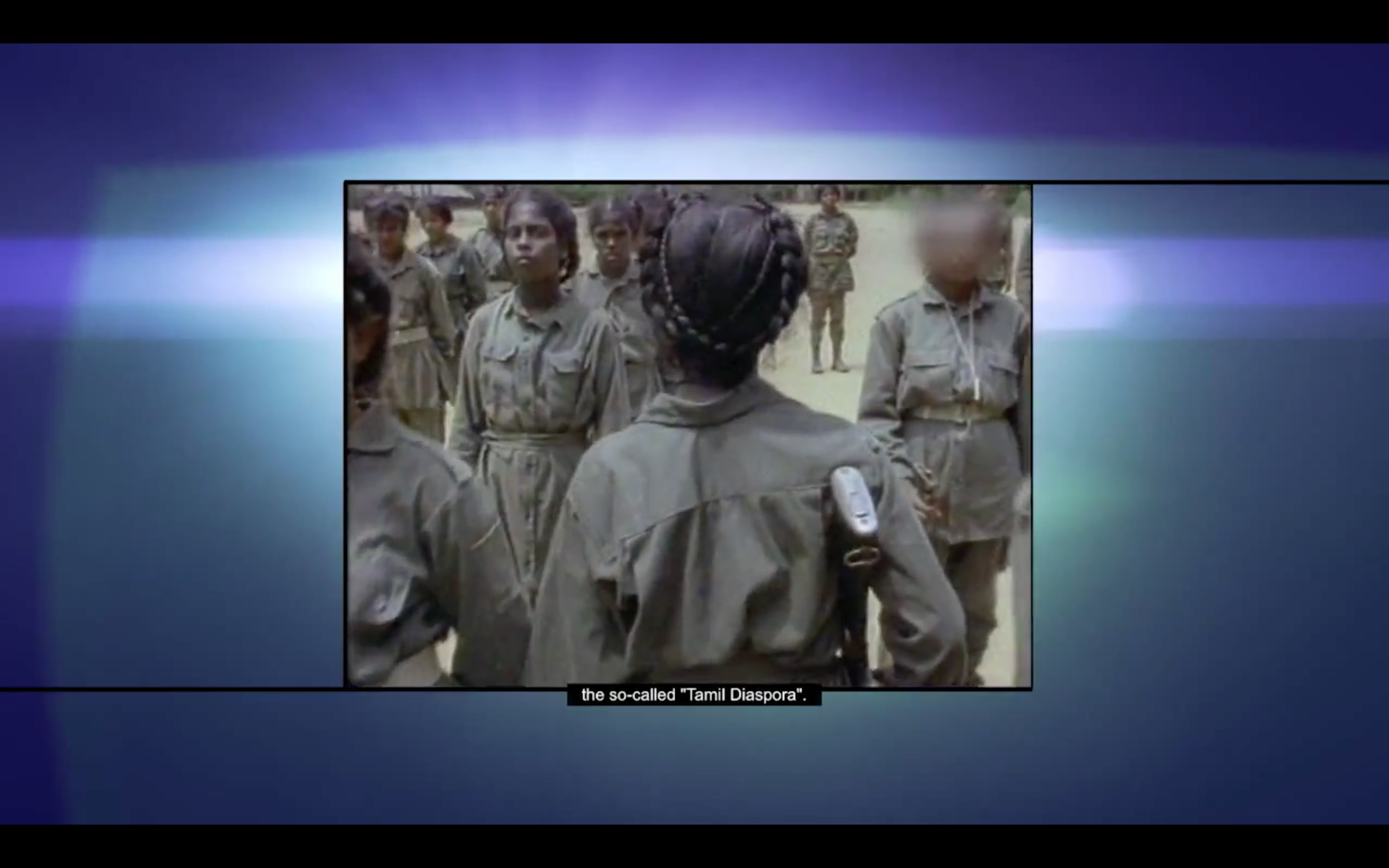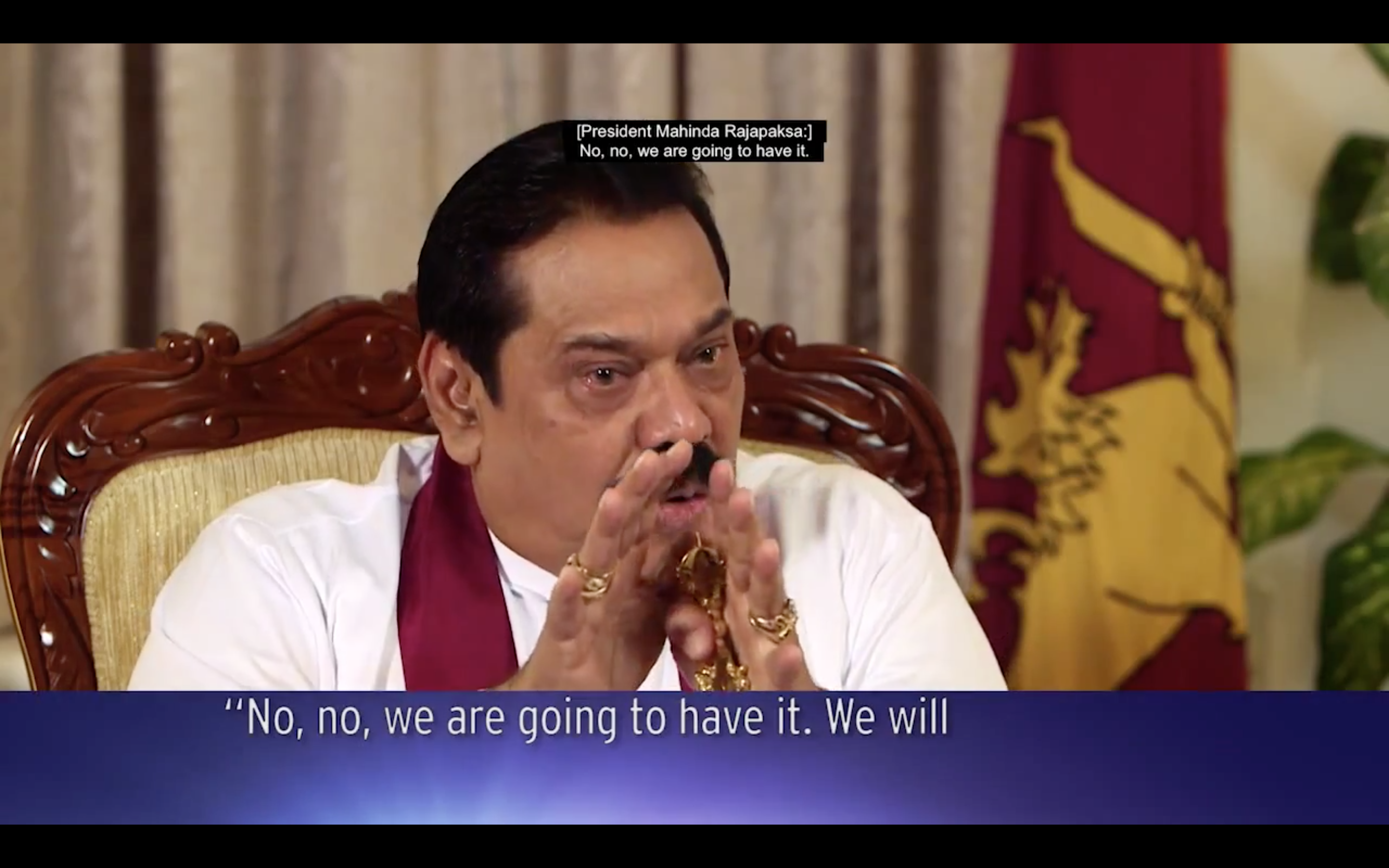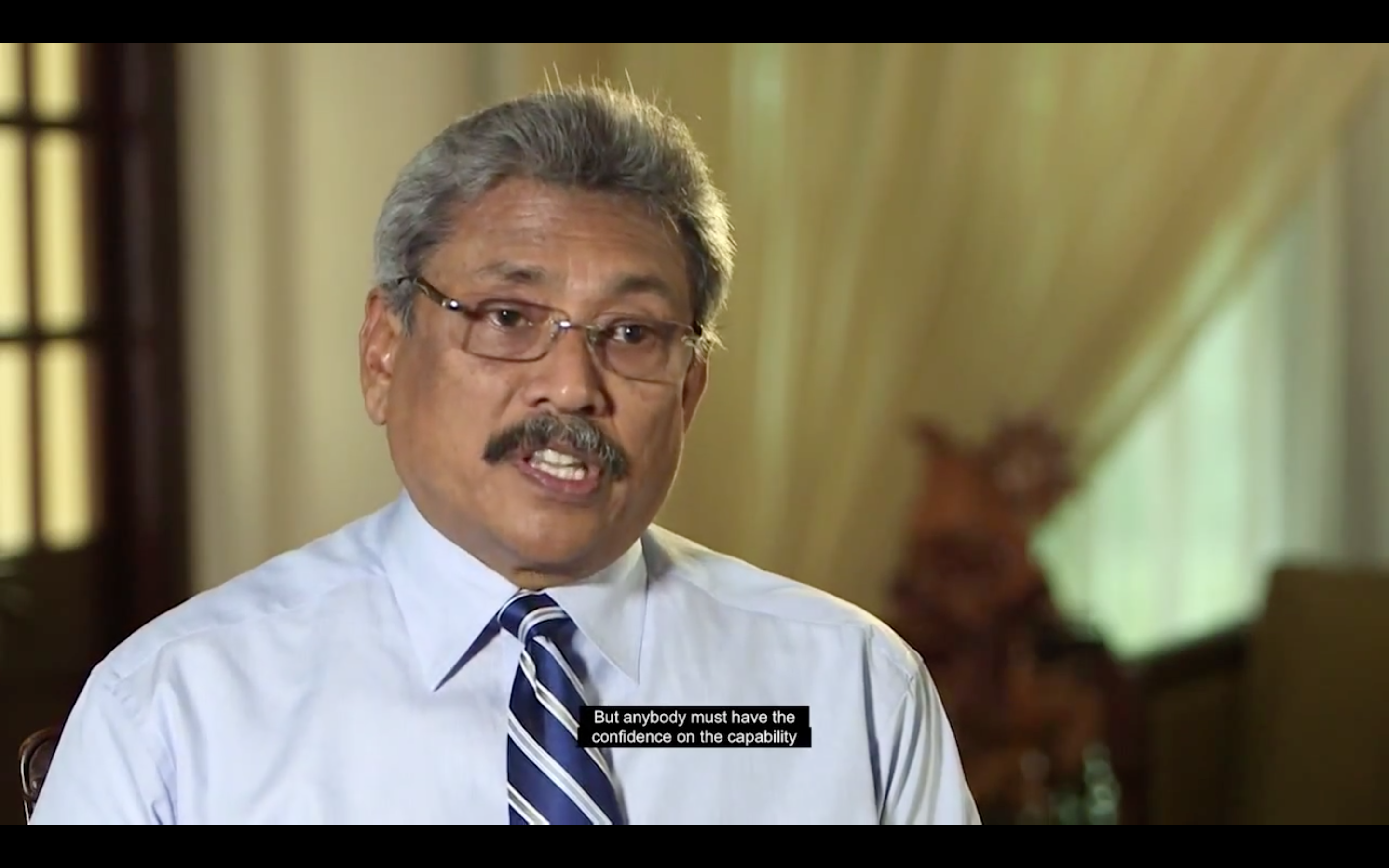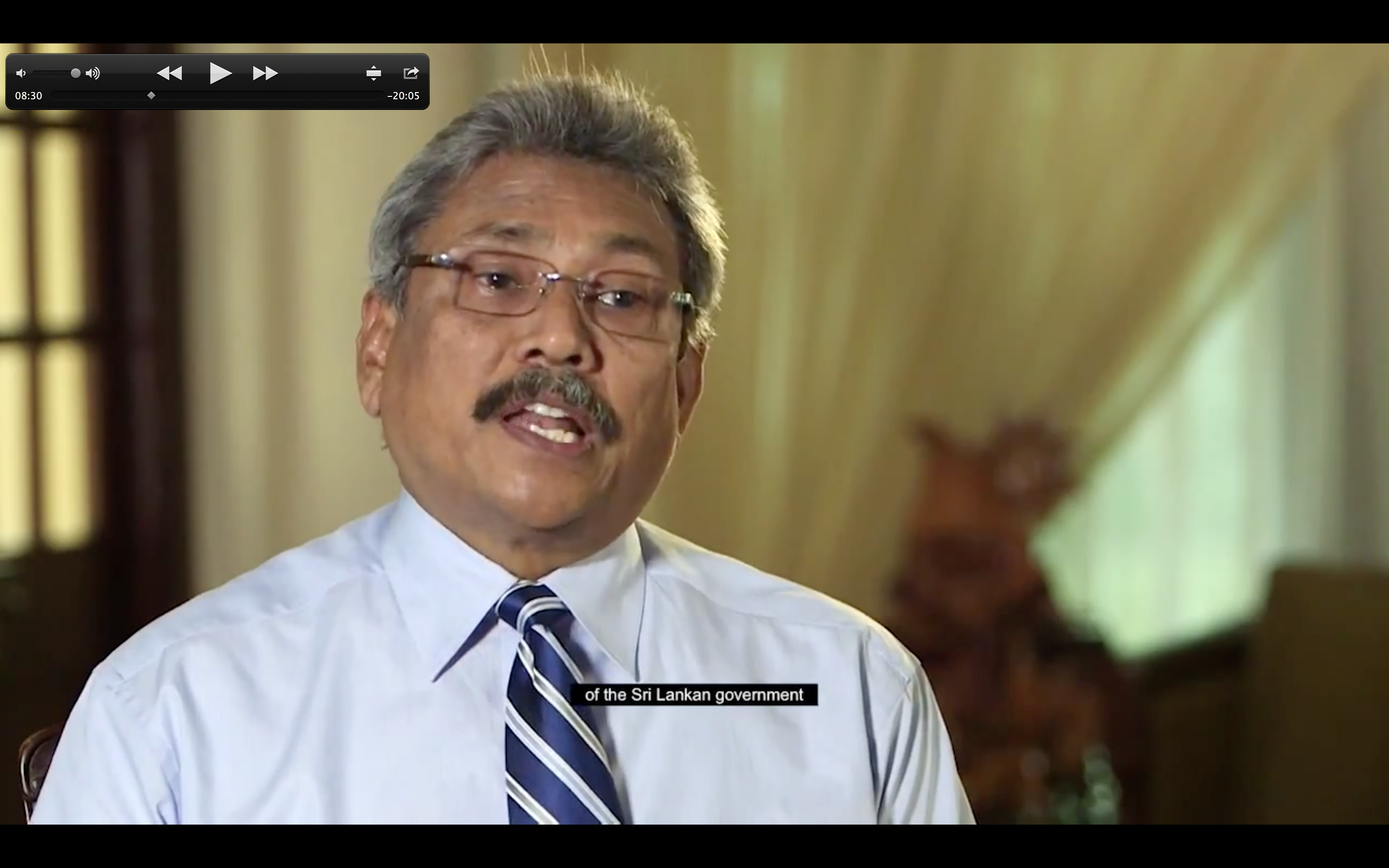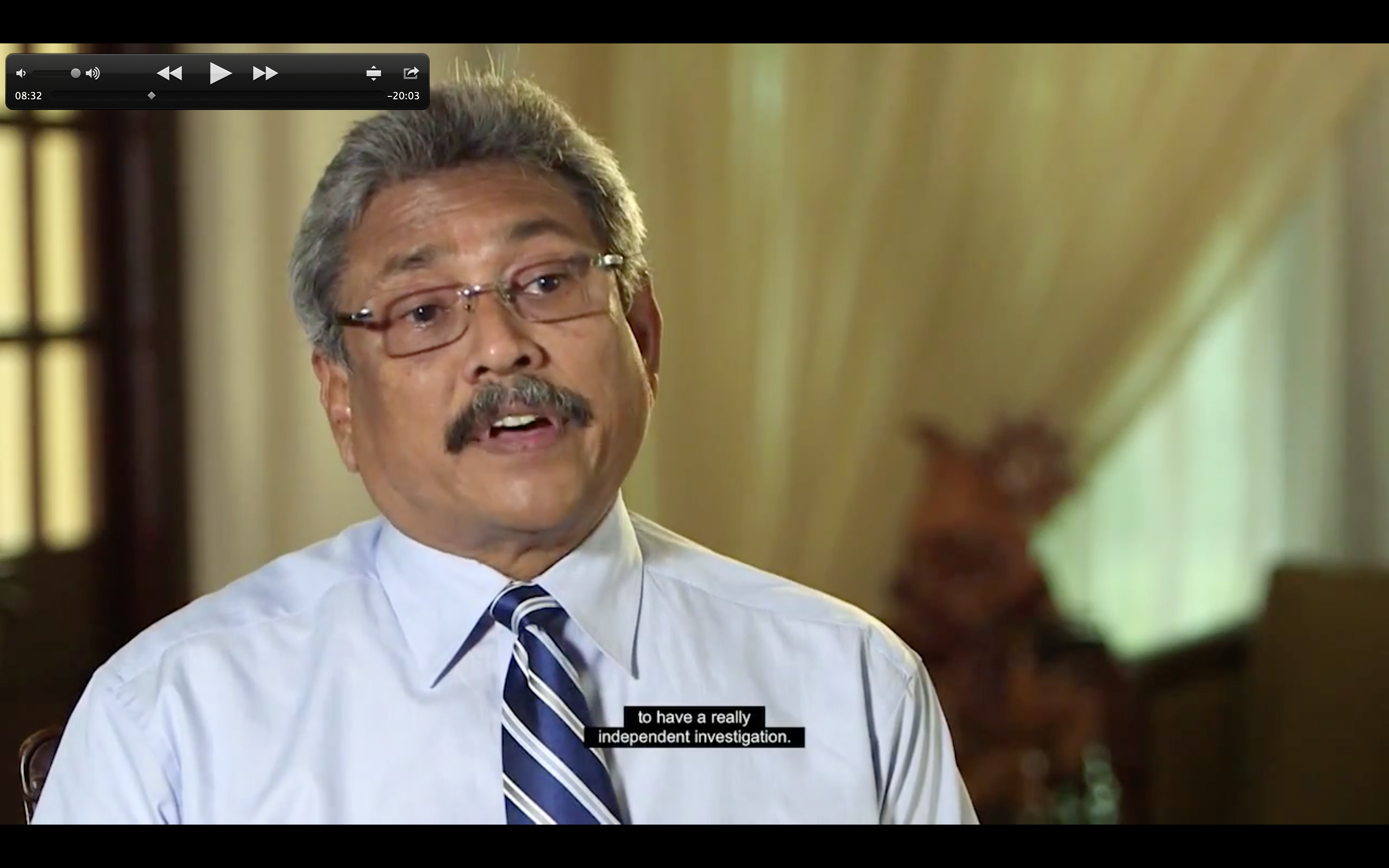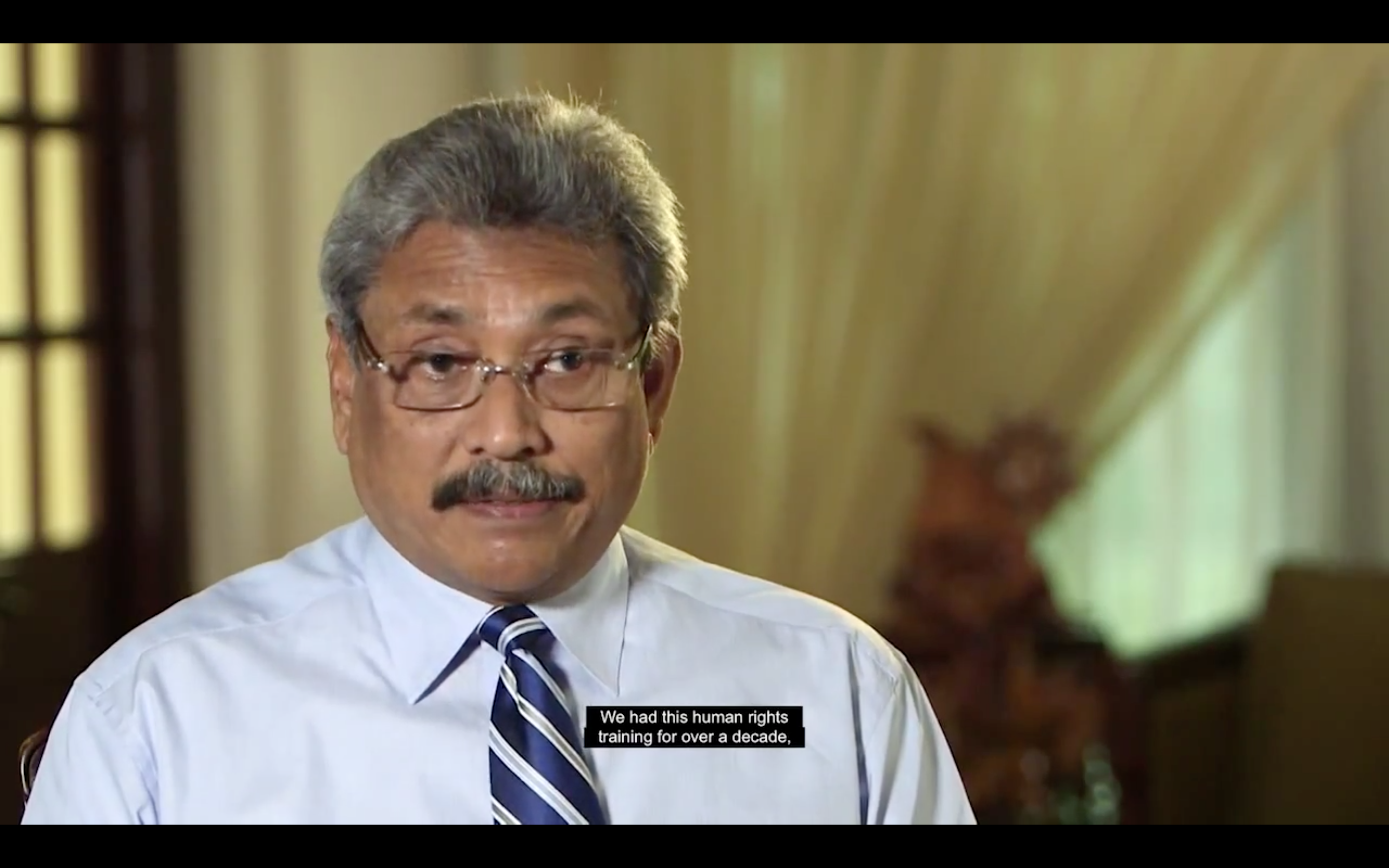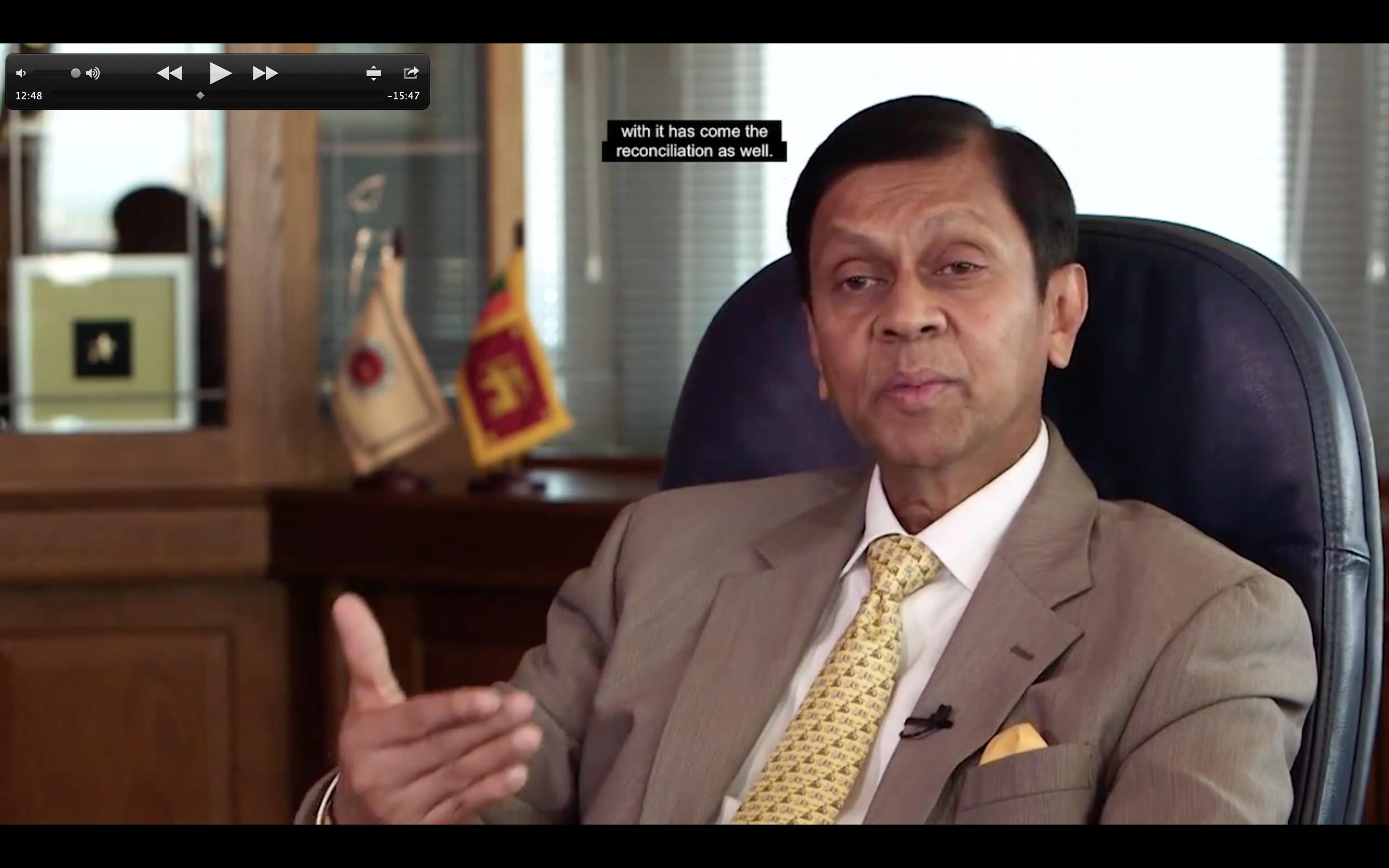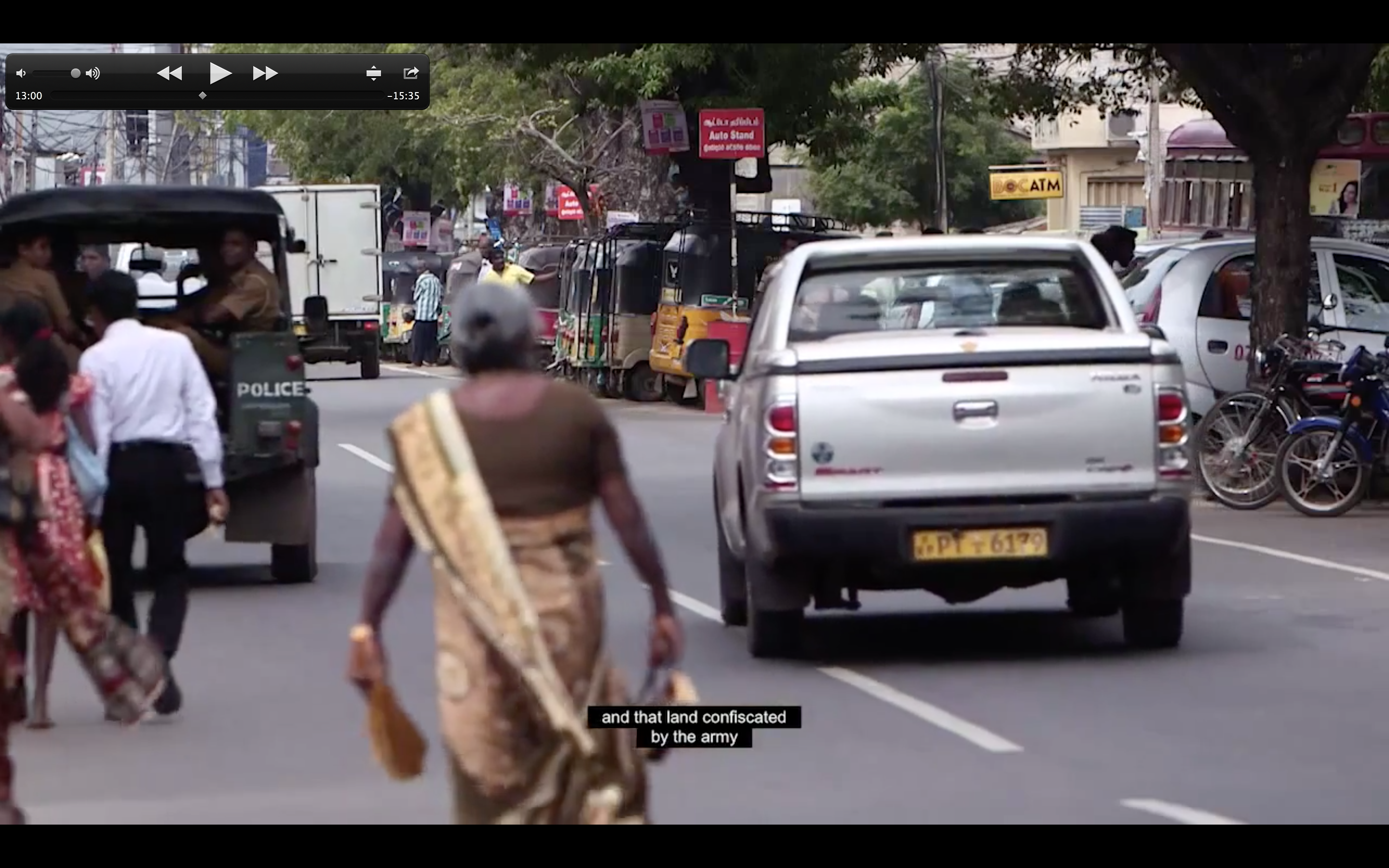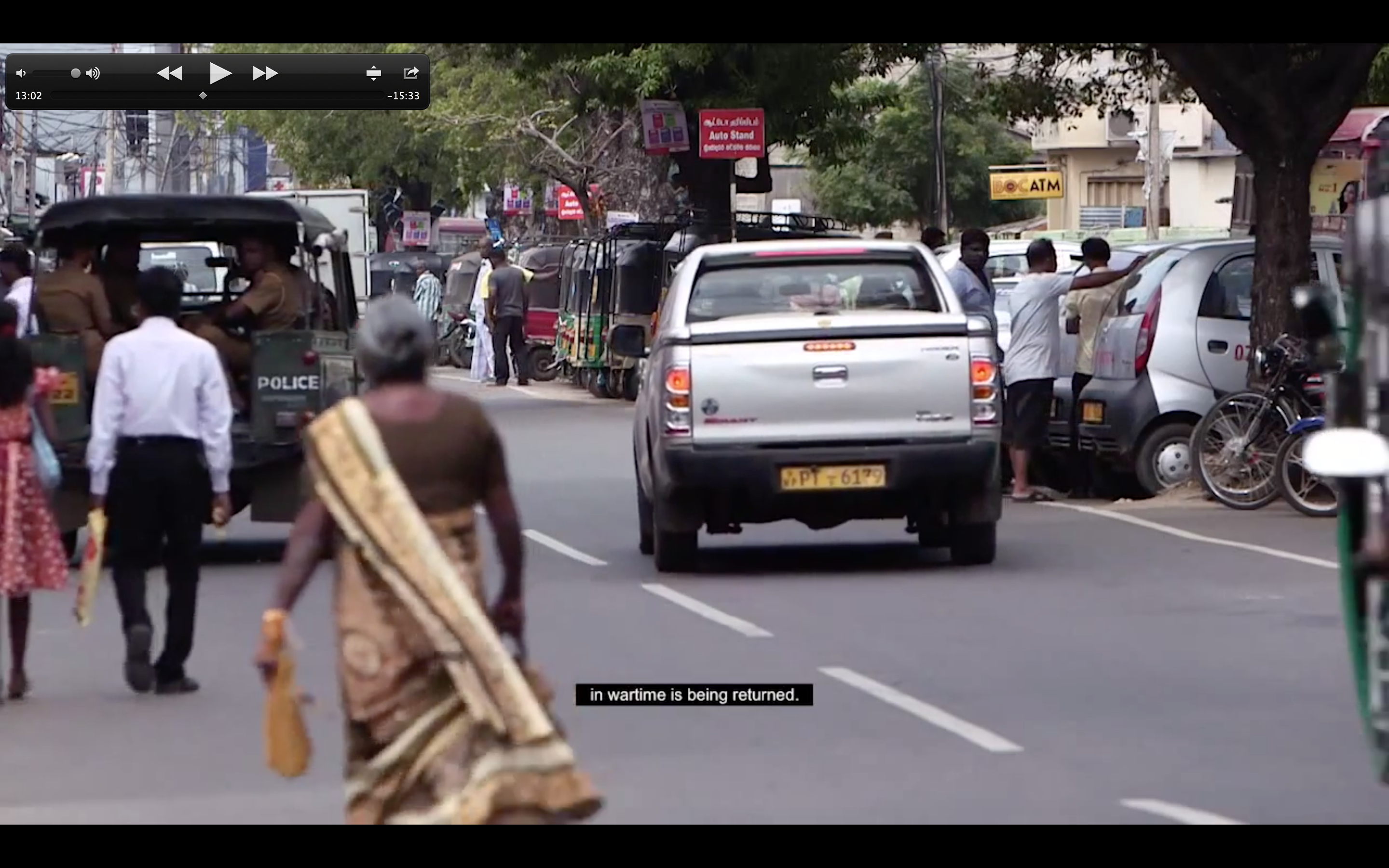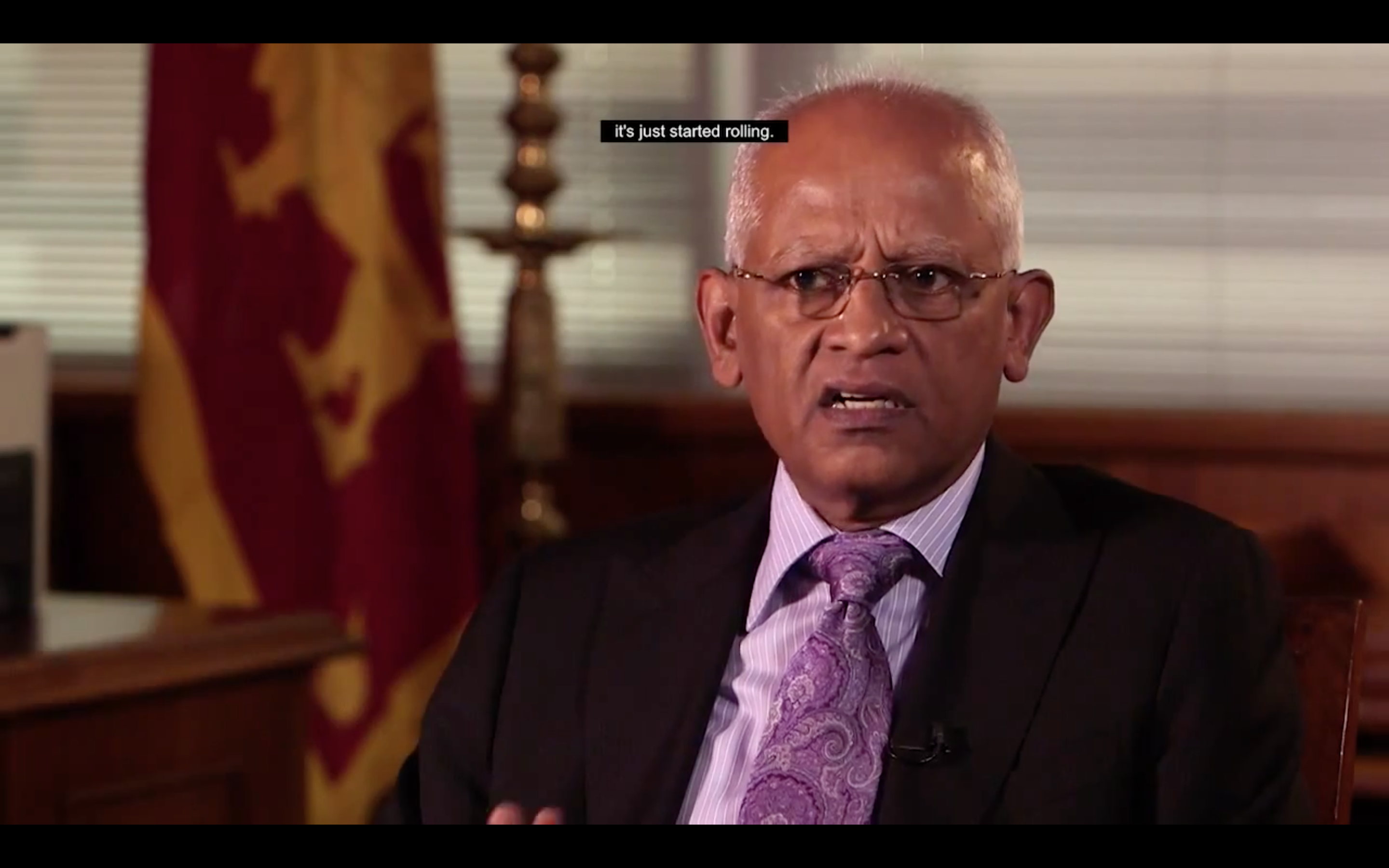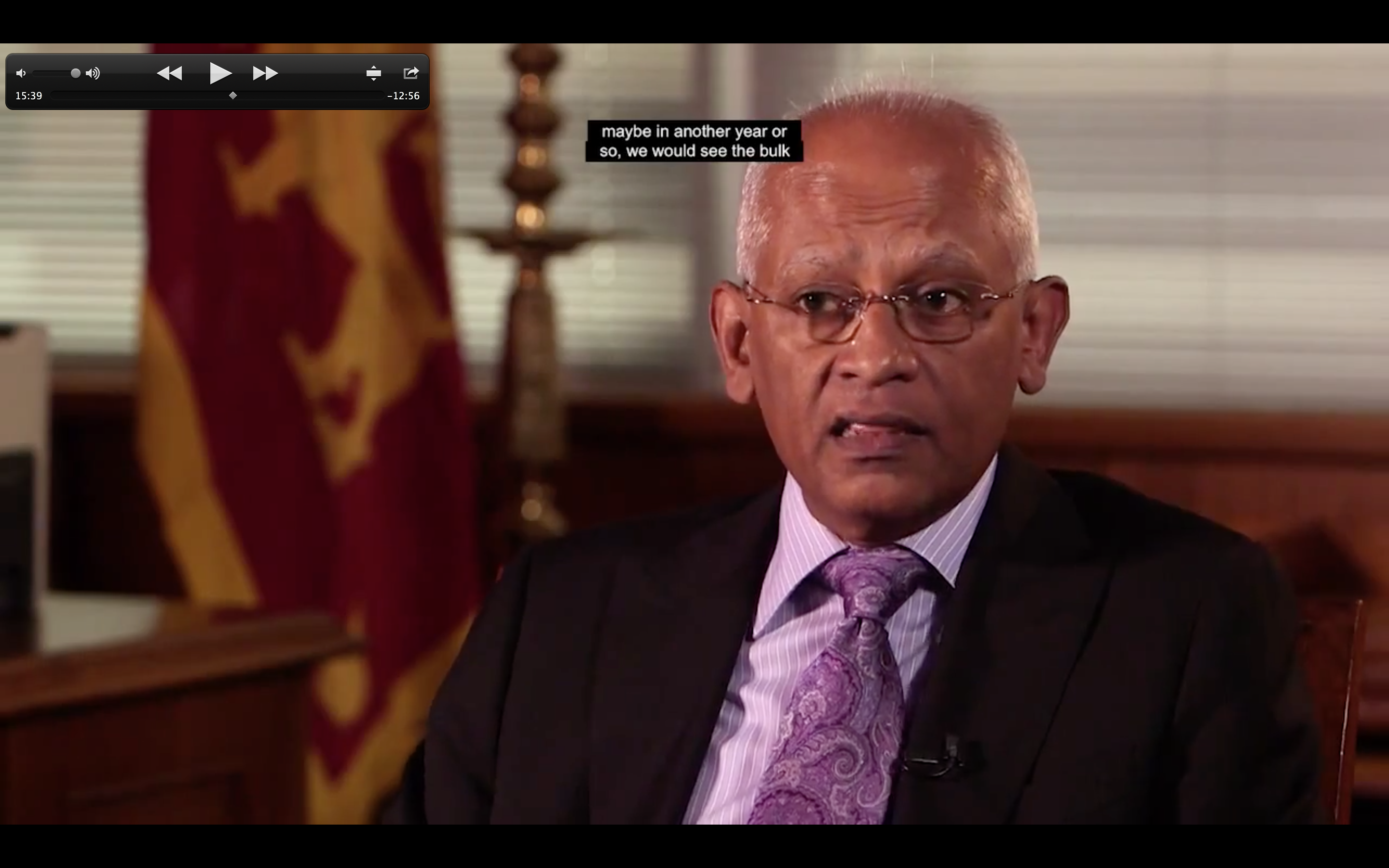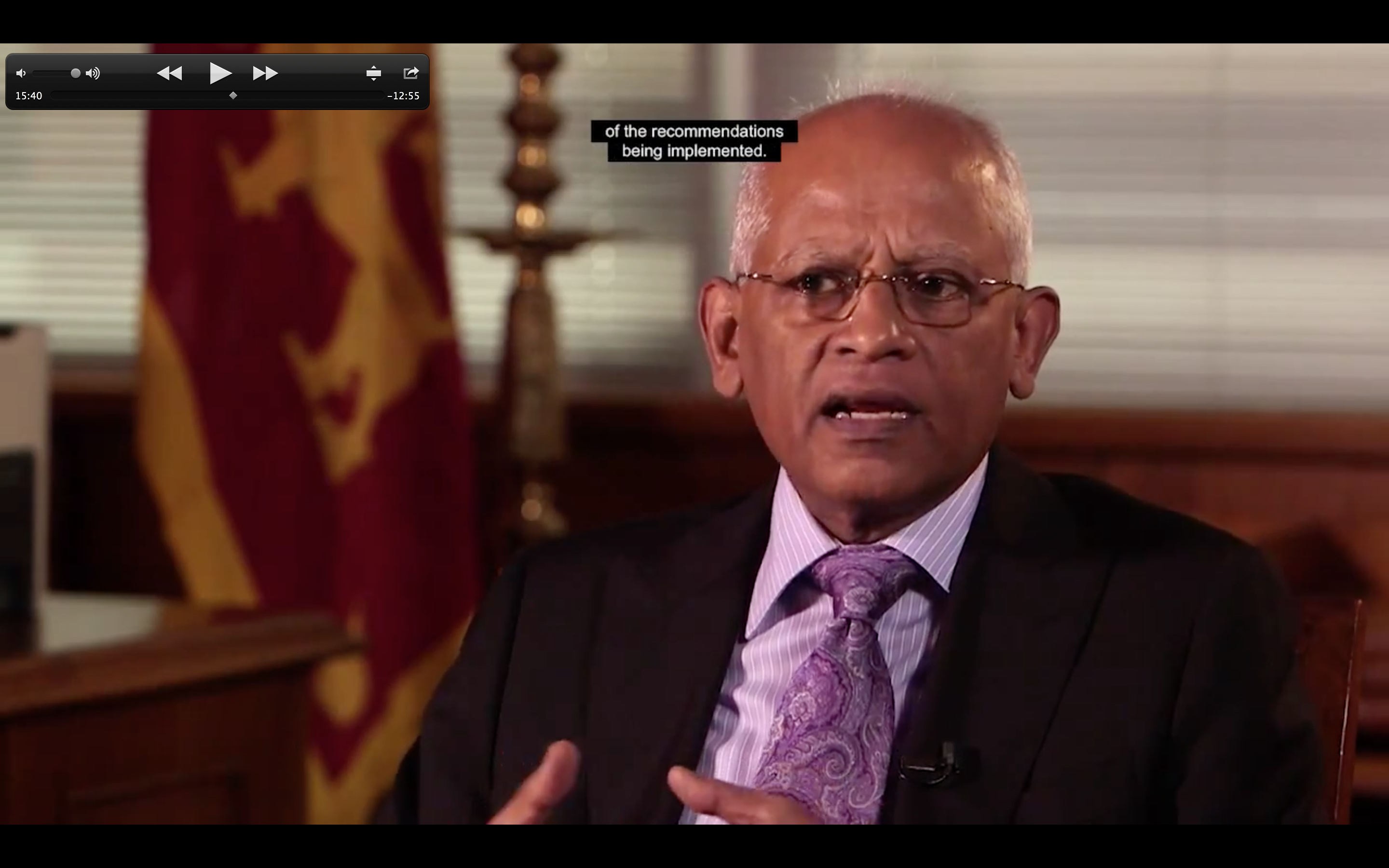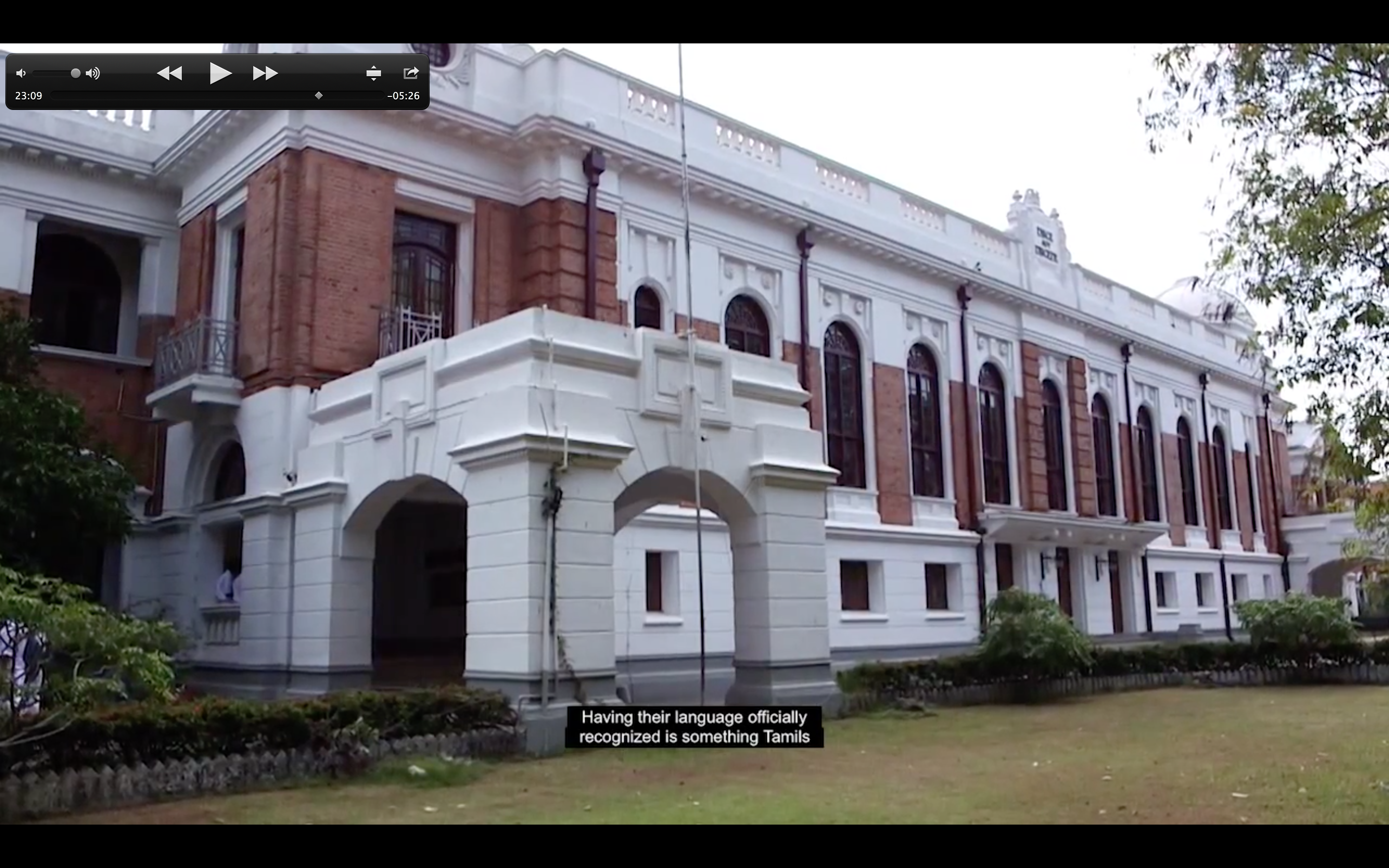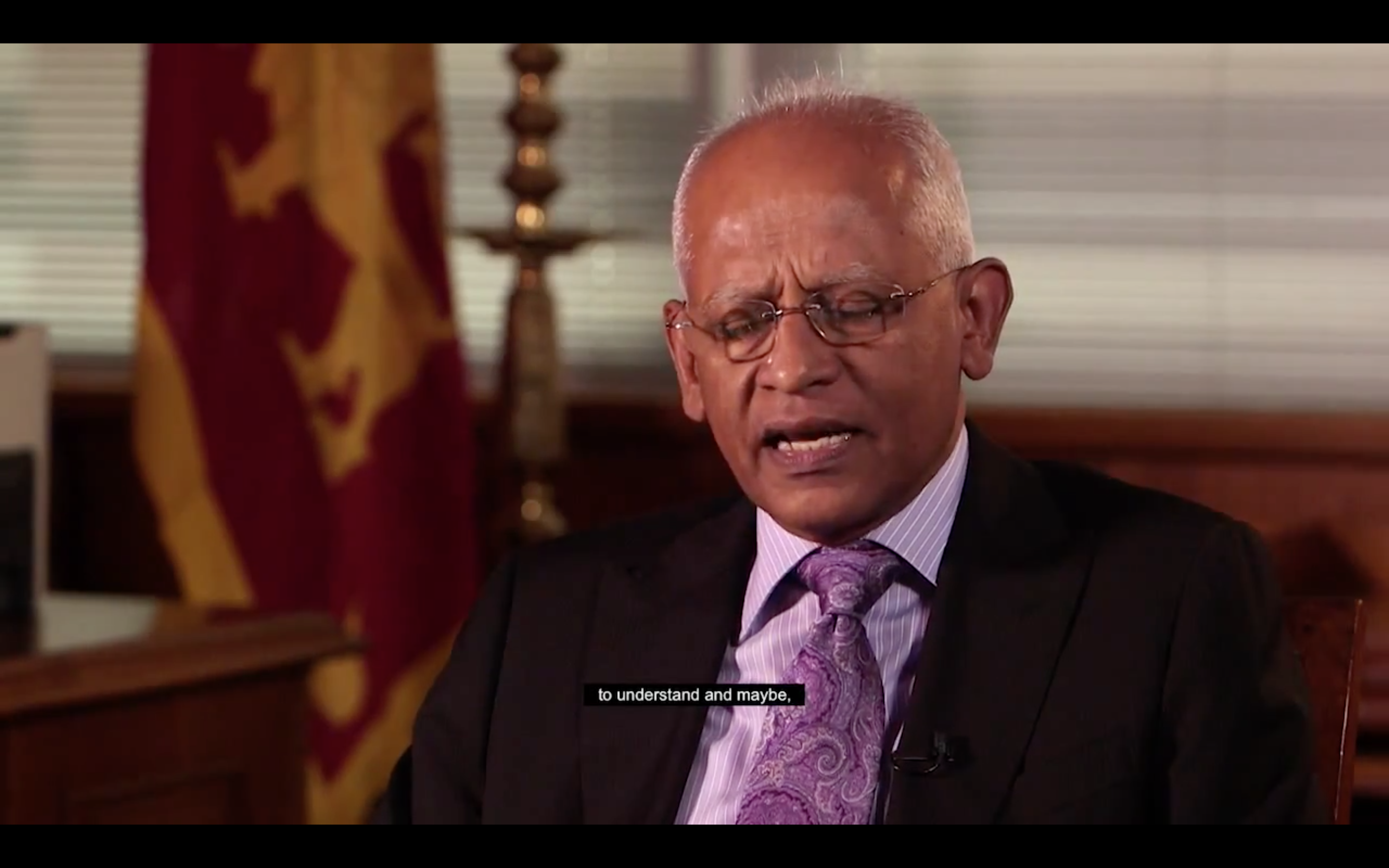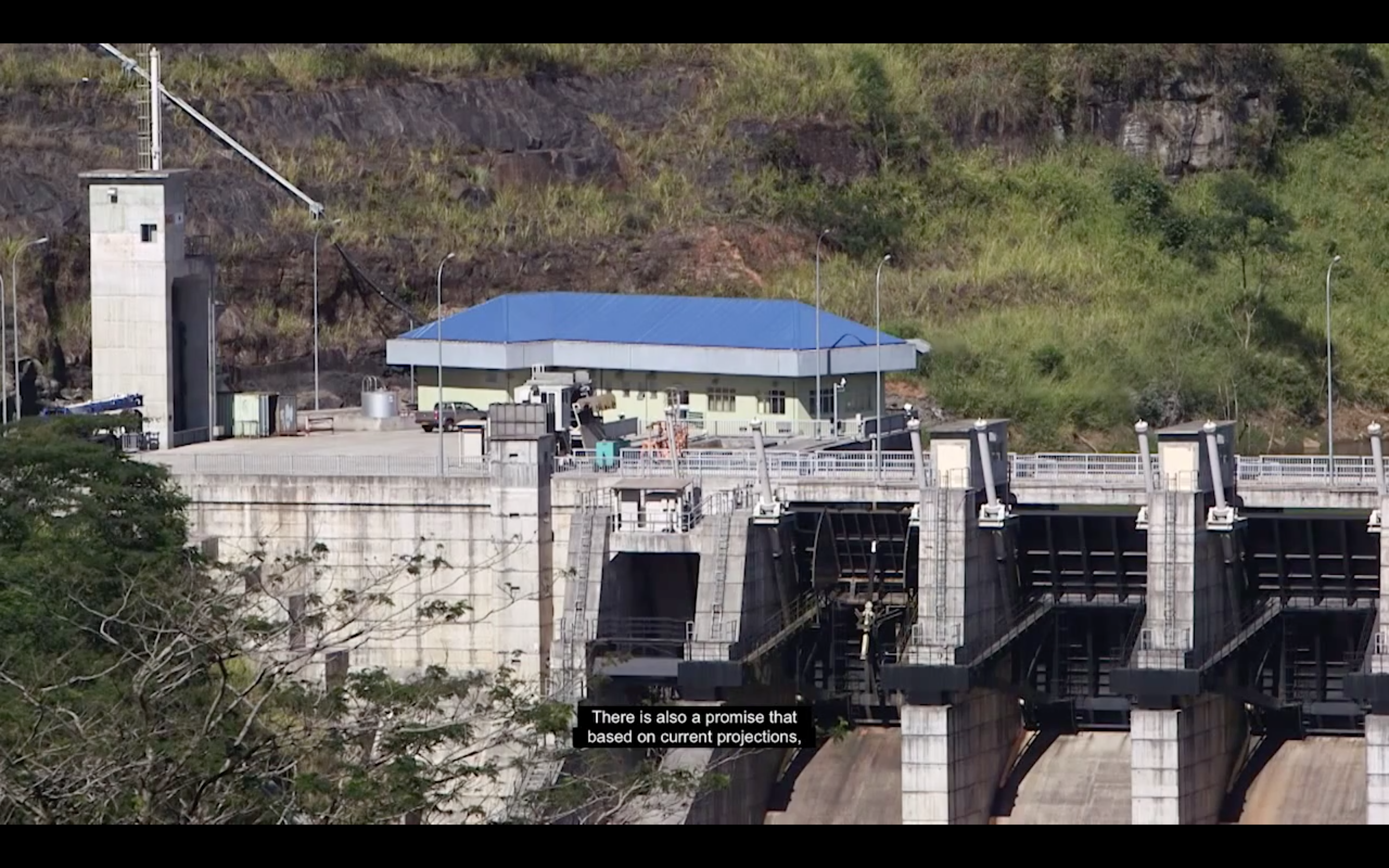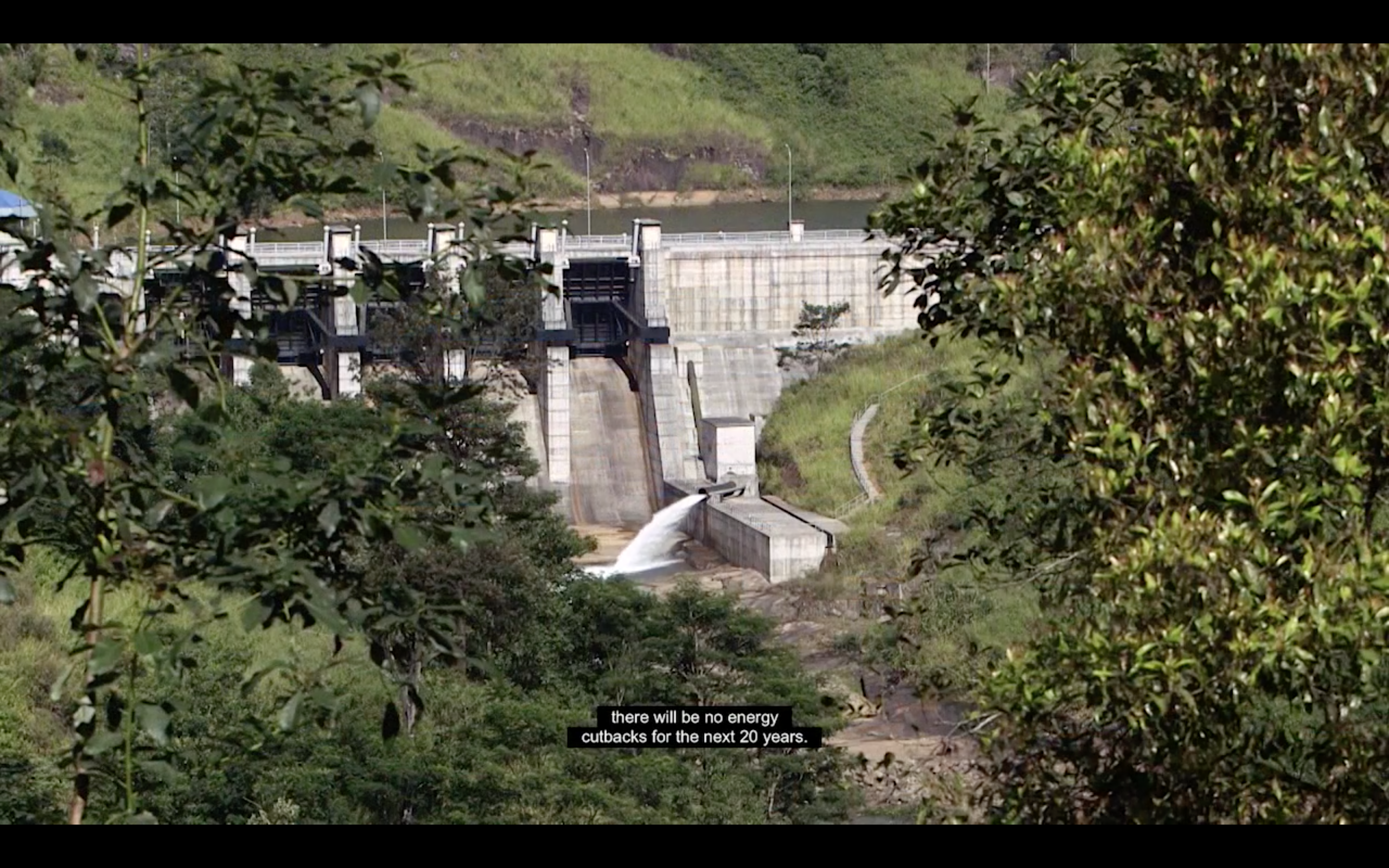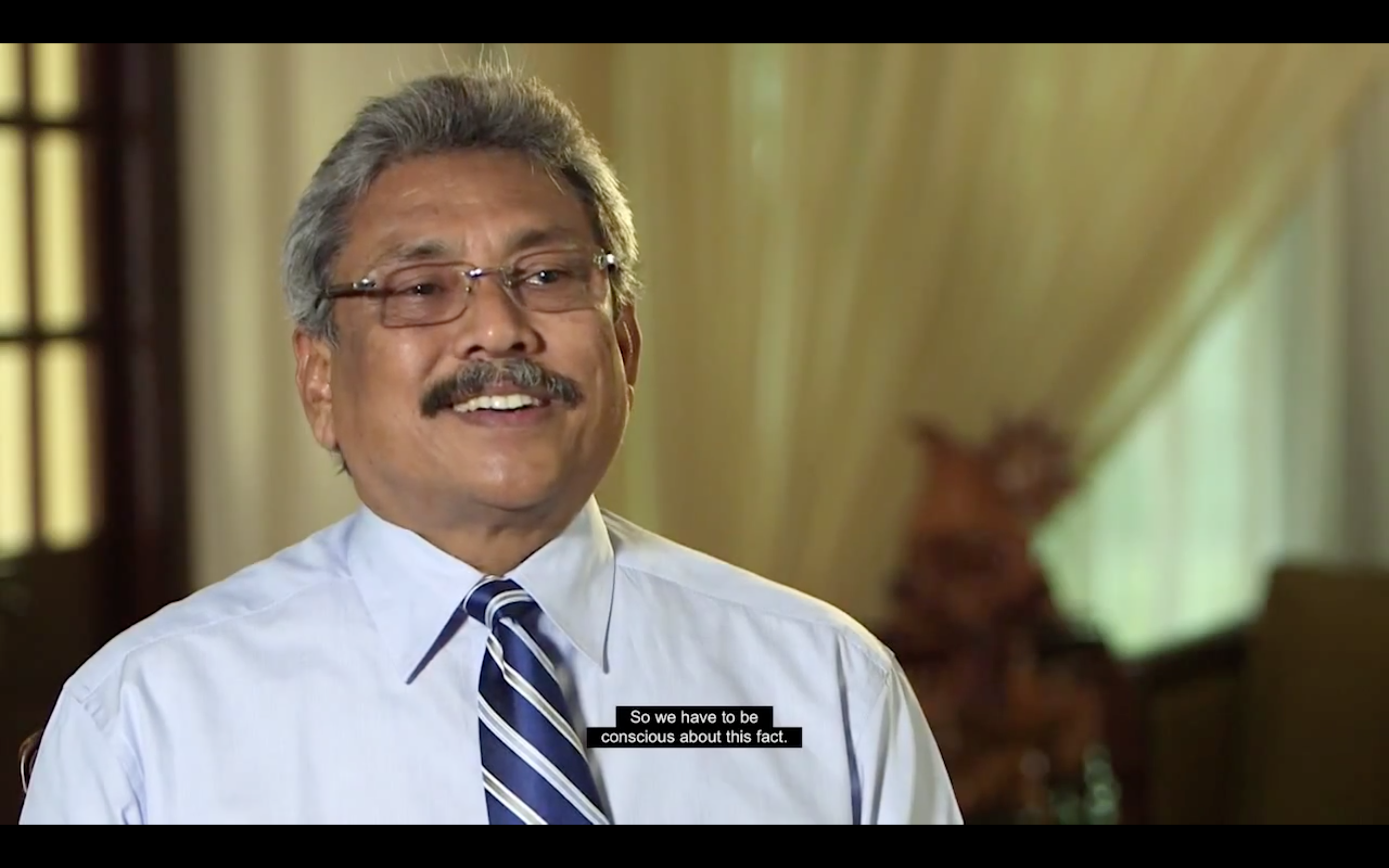[Editors note: Apologies for the sluggish loading time of this page if on a relatively slow Internet connection, on account of the high-resolution images embedded in it.]
The 30-minute “documentary” on Sri Lanka produced by the Thompson Advisory Group (TAG), freely available on YouTube, is a key ingredient in the Rajapaksa regime’s charm offensive in the lead up to the UN HRC sessions in March. The “documentary”, Sri Lanka: Reconciling and Rebuilding, perhaps gets its name from an article published on the Forbes website in November last year, titled Sri Lanka: Rebuilding, Reconciling And Rebranding by the Governor of the Central Bank.
As the Sunday Times newspaper flags, the the Central Bank of Sri Lanka pays the US lobbying firm Thompson Advisory Group LLC US$ 66,600 (Rs. 8,337,600) a month for its services. What this “documentary” is then is rank propaganda, albeit produced very well, with compelling visuals and a well scripted storyline.
Let’s start with the “journalist” who narrates the “documentary” – Gene Randall, a former CNN correspondent. This is a man who was employed by Chevron, the third largest corporation in the US according to the Columbia Journalism Review, to cover-up the company’s role in allegedly contaminating the Ecuador region of the Amazon rain forest and facing a $27 billion lawsuit filed against it. The CJR article, based in turn on an article published in the New York Times in 2009, provides useful context for Randall’s production on Chevron in response to an investigation by 60 Minutes,
60 Minutes correspondent Scott Pelley’s investigation presented multiple perspectives while Randall’s included only Chevron officials and consultants. Everyone interviewed in Randall’s piece, in other words, was paid by Chevron, including Randall himself.
Emphasis ours. The CJR article ends by noting,
With a burgeoning army of out-of-work journalists to lure with lucrative PR contracts and the simultaneous explosion of viral media, corporations are well positioned to gain from journalism’s loss. A legion of Gene Randalls “reporting” is certainly an unsettling future.
What we have then is a known mercenary, with a dodgy website, no discernible ethics in journalism, used here in the service of State propaganda, employed by and paid for by the Government of Sri Lanka. So this is what our tax money is supporting these days.
The “documentary” itself has a number of interesting points that we’ve chosen to highlight, frame by frame. Click on any of the images below to see the high-resolution version, which are taken from the original film.
The film early on notes that “… the government prides itself on a tradition of religious tolerance”. This is a blatant lie, and no report coming from the country from the time the mosque in Dambulla was attacked in April 2012 suggests otherwise. The government turns a blind eye towards violent Buddhist monks, who then go on to lie about their use of violence. This BBC report covers the religious intolerance, aided and abetted by the Government, over just 2013. Buddhist monks who don’t espouse the extremist views of the radical elements in the clergy have themselves been attacked. An online poll conducted in April 2013 clearly flagged the rise of Sinhala-Buddhist extremism in the country and the degree to which the clear association by the President’s brother and Secretary of Defence, Gotabaya Rajapaksa, was perceived to strengthen these violent groups. Also in April 2013, the Sri Lankan Police made their partiality towards religious extremism abundantly clear. As noted on Groundviews at the time,
Clearly then, in Sri Lanka today, Buddhist “monks” destroying private property are kosher, but citizens attempting to light a candle, and walk peacefully in solidarity, are fit to be physically assaulted, hurled abuse at, arrested, intimidated and brutishly dispersed.
The film goes on to note that Muslims make up for around nine percent of Sri Lanka’s population and that they have been in Sri Lanka since the time the Arabs dominated Indian Ocean trade in the 15th Century.
This recognition however holds no sway in how the Muslim community has been defined and targeted by extremist elements, fuelled in turn by the Government’s silence and inaction. As noted by the New Internationalist last year,
As Javid Yusef, founding Secretary General of the Peace Secretariat for Muslims in Sri Lanka explained… the BBS have manufactured ‘distrust of the Muslims among Sinhala Buddhists by spreading untruths, half truths and lies among the populace’. These have included advocating a ban on both Hijab and Halal meat certification and campaigns encouraging the Sinhalese community to boycott Muslim-owned shops and businesses (based on claims ranging from the false: that shop-owners have been concertedly converting their female Buddhist employees to Islam, to the nonsensical: that shop-owners were giving free miscarriage-inducing sweets to their Sinhalese customers).
The divide between the communal and religious harmony the film attempts to portray and ground realities could not be more stark. The film goes on to note that Sri Lanka’s “more recent past has been marked by a ferocious civil war – 26 years of fighting between Tamil insurgents and the government”.
Problem is, the film then goes on to conflate “Tamil insurgents” with “Tamils”, directly playing into and further strengthening the Rajapaksa regime’s perspective, that endures post-war, that if one is Tamil, then one is a separatist. The film notes that “Tamils insisted on having their own state in the North and East of the island”.
Whether by directorial design or accident, this violent conflation of what was a terrorist group and larger, more diverse community in Sri Lanka clearly demonstrates the inherent racism of the Rajapaksa regime, given that this film would have invariably been approved by those who commissioned it, with this sentence as it stands.
Randall’s lack of ethics, possibly on instruction by the Rajapaksa regime, is again highlighted in the non-disclosure of the party political affiliation of MP Arun Tambimuttu, featured in the film as someone who suffered the LTTE’s violence. Tambimuttu is the SLFP Organiser for Batticaloa.
The film goes on to claim that the “government is conducting a post-war census”, which though imprecise, possibly refers to the ‘Census on human and property damages due to conflict’ conducted late last year.
The census is an unmitigated sham. Groundviews has published the census forms in full, with detailed analysis as to why the census results cannot be believed.
Like the film’s conflation of Tamil and Tamil insurgents, the film makes even more incredible claims regarding the Tamil diaspora.
The film’s reductionism is mind-boggling. The whole Tamil diaspora – all of them, all over the world – is defined as those “who left the country after the war”, are “militant” and engaged in “fundraising propaganda”.
Randall goes on to cajole a rather incoherent President to say that the government is interested in a Truth and Reconciliation Commission, aided by South Africa.
As columnist Kishali Pinto Jayawardene avers,
Despite Sri Lanka’s most disgraceful history with a plethora of demonstrably useless Commissions and Committees established by successive Presidents, it is a matter for considerable astonishment that the Rajapaksa Presidency’s near desperate proposal of a Truth and Reconciliation Commission at the turn of this year, appears to have found support in some quarters of our society… At each and every turn, these clever diversion tactics of Commissions and Committee turned attention away from imperative legal and policy reforms, strengthening of the judicial system and restoring the constitutional balance of power which (make no mistake about this) are essential to handling Sri Lanka’s ‘accountability problem’ as is somewhat quaintly termed by some. And Sri Lankan governments, regardless of their political colour, are able to resort to these tactics time and time again and without challenge from this country’s so-called ‘intellectual’ community precisely because of this self serving blindness. Forget about Governments; we should be ashamed of ourselves.
Her views are supported by a comprehensive study of the commissions and committees appointed by the Rajapaksa regime since 2006 by the Centre for Policy Alternatives (the institutional home of Groundviews).
Quite simply, the report makes for depressing reading and completely ridicules Mahinda Rajapaska’s promise to set up a Truth and Reconciliation Commission in Sri Lanka. Both Pinto Jayawardene’s column and CPA’s report rubbish claims made by Gotabaya Rajapaksa, a little later in the film, around how “anybody must have the confidence on the capability of the Sri Lankan Government to have a really independent investigation”.
Gotabaya Rajapaksa goes on to note that the Army has had human rights training for over a decade.
Whatever training occurred during a decade, it seems to have clearly and comprehensively eluded those in the Army in the last stages of the war.
The Governor of the Central Bank, Nivaad Cabraal makes the assertion – commonly made by the regime – that greater economic prosperity in the North has resulted in reconciliation.
Senior Lecturer of the Department of History at the University of Colombo, Dr. Nirmal Ranjith Dewasiri, writing into Groundviews, critiques this simplistic assumption and ultimately violent erasure of so much of the structural and systemic violence that endures in Sri Lanka, post-war,
Post-war politico-ideological interventions in relation to the North are fascinating and quite significant. Apart from continued military presence and “development process” as defined by the Sinhala state in line with neo-liberalism, there are other ideologically driven interventions. Pilgrimage has become one such phenomenon. Sinhala-Buddhist pilgrims who are flocking into Jaffna peninsula in large numbers I will argue are engaged in a politico-ideological act rather than a religious act. Beneath the official rhetoric of bringing about ethnic harmony through North-South people to people encounters, these pilgrimages reproduce conflicting interests between Sinhala and Tamil ethno-nationalist identity politics. Although pilgrimage has provided much needed economic benefits for the North, they have at the same time created a sense of anxiety among politically and ideologically conscious Tamils.
The film makes other untenable claims, for example over the return of land confiscated by the Army.
What makes this a particularly pernicious falsehood is the degree to which the Sri Lankan Army is taking over land in Kilinochchi and Mullaitivu Districts post-war, as well as in the Ampara District.
Asked about the progress of implementing the LLRC’s recommendations, the President’s Secretary Lalith Weeratunga notes that the “it’s just started rolling” and that “maybe in a year or so we would see the bulk of the recommendations being implemented”.
This assertion is incompatible with independent monitoring of the implementation of the LLRC recommendations (by Verite Research), which clearly flag poor implementation or no implementation plans whatsoever across the subset of recommendations from the LLRC report the Government decided to ostensibly focus on. The government’s own score card from 2013.09.06 is entirely unbelievable – one has only to read the supposed progress noted on Page 50 (regarding media freedom) and juxtapose it with attacks on local media over 2013, plus the attacks on international media who came to Sri Lanka during CHOGM 2013.
Also integral to the LLRC’s recommendations is the use of Tamil as an official language. The film correctly notes that “having their language official recognised is something Tamils have long demanded”.
The film’s submission is underscored by Lalith Weeratunga who flags the importance of the Sinhalese and Tamil communities speaking each other’s language as vital to post-war reconciliation.
Problem is, leave aside the challenges around the promotion and use of Tamil in government affairs across the country post-war, the Rajapaksa regime can’t even get the Tamil on the Official Languages Commission website right!
Serious mistakes of #Tamil in official website of Official Languages Commission | @groundviews @vikalpavoices #lka pic.twitter.com/IJk689PCnR
— மாற்றம் (@MaatramSL) February 6, 2014
It is very hard to imagine a government unable and unwilling to correctly use Tamil on a website to be able to meaningfully embrace and champion its use as a vital peg of reconciliation in the country writ large.
The film goes on to highlight the new expressway to the airport, but with no mention whatsoever about the eye-watering cost to the tax-payer, notwithstanding the convenience of getting to and from the airport quicker. As noted in the Tamil Guardian,
Whilst China’s massive development loans to Sri Lanka are often portrayed as rescuing the Rajapakse administration from international economic pressure over human rights abuses, the details tell a different story. While China’s loans are an immediate de-facto handout for Chinese companies (which Sri Lanka is obliged through conditionalities to hire and purchase from), future Colombo governments will be left with the debts – at interest rates higher than other developmental lenders ask for.
The film also makes some interesting claims about electricity generation in Sri Lanka, noting that “based on current projections, there will be no energy cutbacks for the next 20 years” and that soon, 100% of Sri Lanka will be covered by the electric grid.
The film makes no mention about the colossal losses incurred by the Sri Lankan public by the repeated breakdown of the Norochcholai Coal Power Generation plant. As noted by mainstream media, the coal power plant has broken down 25 times since March 2011. Despite this,
Regardless of the continuous breakdowns at Lakvijaya Power Station in Norochcholai, the Government has awarded the second phase of the project to the same contractor – China National Machinery Import and Export Corporation – based on the strong conditions found on the loan agreement signed with China Exim Bank. These conditions have “handicapped the Government” to consider another contractor but to continue with China National Machinery Import and Export Corporation “without obtaining a technical fault report during the phase one”.
Perhaps the most disturbing aspect of the film is Gotabaya Rajapaksa noting that despite rehabilitation and reintegration, all ex-combatants of the LTTE pose a threat to Sri Lanka’s national security.
What he is espousing, in other words, is a constant surveillance and military apparatus, particularly in the North and the East, that for over the lifetimes of these ex-combatants, will continue to probe and monitor them, for the perceived threats they pose because of their past. The tragedy is that those forcibly recruited by the LTTE, and parents who had to involuntarily give up their children, now have to suffer the indignity and real consequences of being treated as forever suspect by the Rajapaksa regime.
So there you have it. A 30 minute “documentary” that’s part of a multi-million rupee PR campaign, broadcast on the NBC Network in the US recently, with the intention – as far as we can gather – of generating greater US investment in a country. From the presenter to the group that was paid to create it, from those featured in it from government – all men – to the outright lies and half-truths contained in it, this film is what the government believes will help generate positive spin on Sri Lanka’s post-war prospects. While there is invariably much to be happy about our post-war landscape, the shameless chutzpah of this film lies in the belief, by government, that slick productions and beautiful visuals are able to erase the very real violence that endures post-war, and the human rights violations for which it is responsible for.
Sadly, it’s a chutzpah funded by all of us.

